What Is ChatGPT?
ChatGPT is a natural language processing tool developed by OpenAI that generates human-like text based on the input it receives. You can think of it as a high-tech conversation partner or writing assistant.
ChatGPT is a type of artificial intelligence (AI) built using a model architecture known as GPT, which stands for “Generative Pre-trained Transformer.”
OpenAI trained ChatGPT on a massive amount of text data from the internet. It’s a type of machine learning model known as a large language model (LLM). Which means it “learns” by identifying patterns in that data and uses them to make predictions.
The tool works by predicting the next word in a sentence over and over again. This allows it to generate complete sentences and paragraphs that sound incredibly human-like.
You simply type in a question—known as a prompt—and it answers back.
Why Has ChatGPT Skyrocketed in Popularity?
Since December 2022, ChatGPT’s popularity has blown up.

It was the fastest-growing app of all time (until its growth rate was surpassed by Meta’s Threads platform in July 2023).
ChatGPT has diverse applications, which makes it a versatile tool across various fields. It also offers a free version to allow anyone to test.
Imagine being able to draft an email in seconds or having an assistant help write your novel. Think about a student getting personalized tutoring at any hour of the day.
For example, ChatGPT can solve math problems for you:
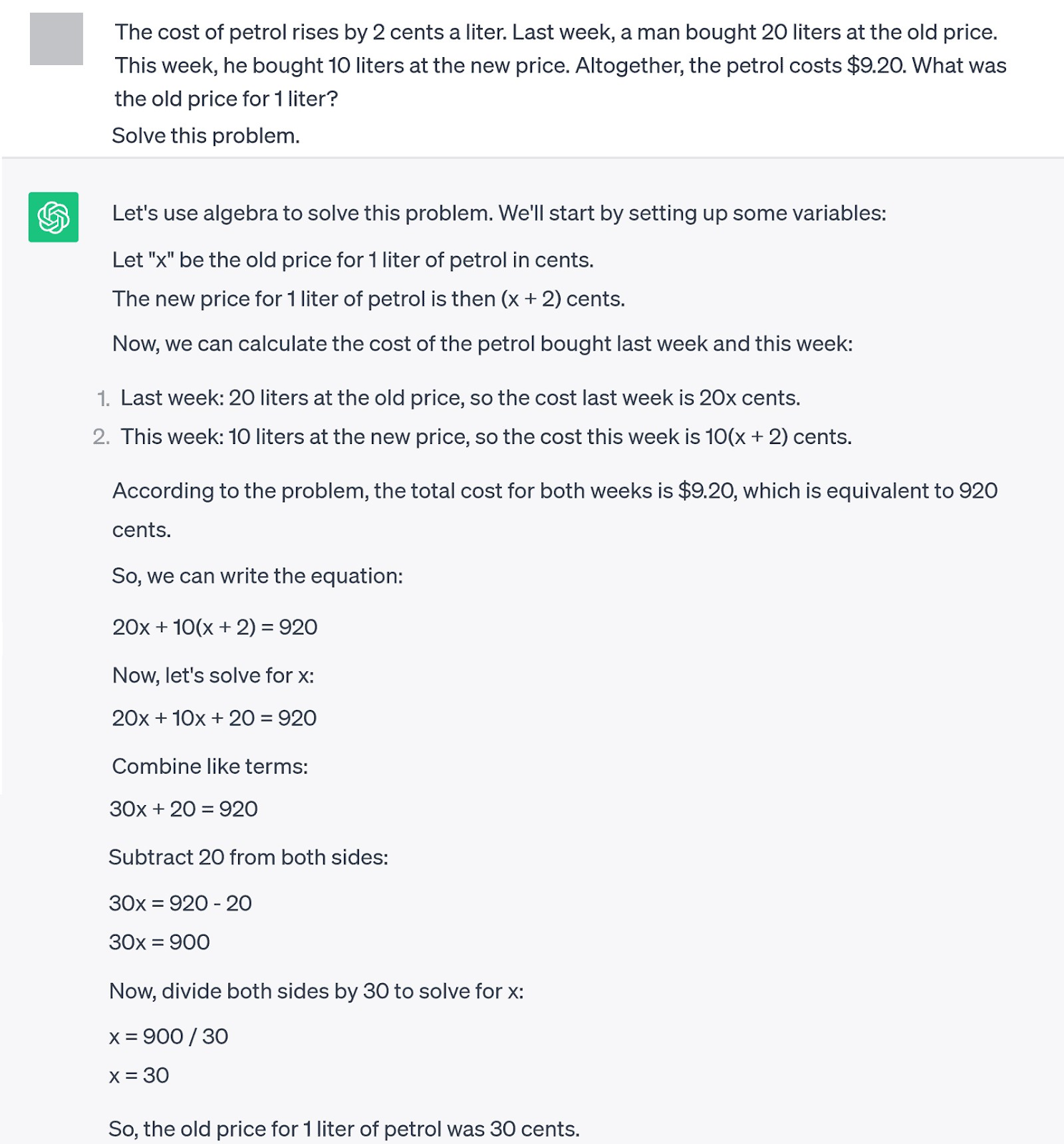
These aren’t futuristic concepts; they’re capabilities ChatGPT brings to the table right now.
ChatGPT’s novelty factor also adds to its appeal. Interacting with AI that can hold a conversation or spin a story based on a few keywords is fun and exciting.
This is precisely what makes ChatGPT popular for personal and professional use.
How Does ChatGPT Affect SEO?
ChatGPT can assist with tasks like generating content or crafting SEO-friendly outlines.
But it can’t replace a comprehensive, carefully planned SEO strategy or the sophisticated search functionality search engines like Google provide.
Here’s why.
Search engines index and search the internet’s information to deliver the most relevant results to users’ queries.
SEO helps websites and content to rank higher in these search engine results.
Both are fundamental to making information discoverable and accessible on the internet.
ChatGPT, on the other hand, is a language model. Its primary function is to generate human-like text based on the input it receives.
It’s best for tasks like writing articles and having conversations. It doesn’t index or search the internet or influence a website’s visibility.
But you can use it to enhance your own SEO efforts. Here’s how.
14 Ways You Can Use ChatGPT to Boost Your SEO Performance
Here are 14 use cases for ChatGPT SEO that you can integrate into your workflow:
1. Conduct Keyword Research
Brainstorm a pool of keywords with ChatGPT, then use a tool like Semrush to evaluate their effectiveness and choose the ones that give your content the most visibility.
For example, let’s use a prompt to generate some long-tail keyword ideas:
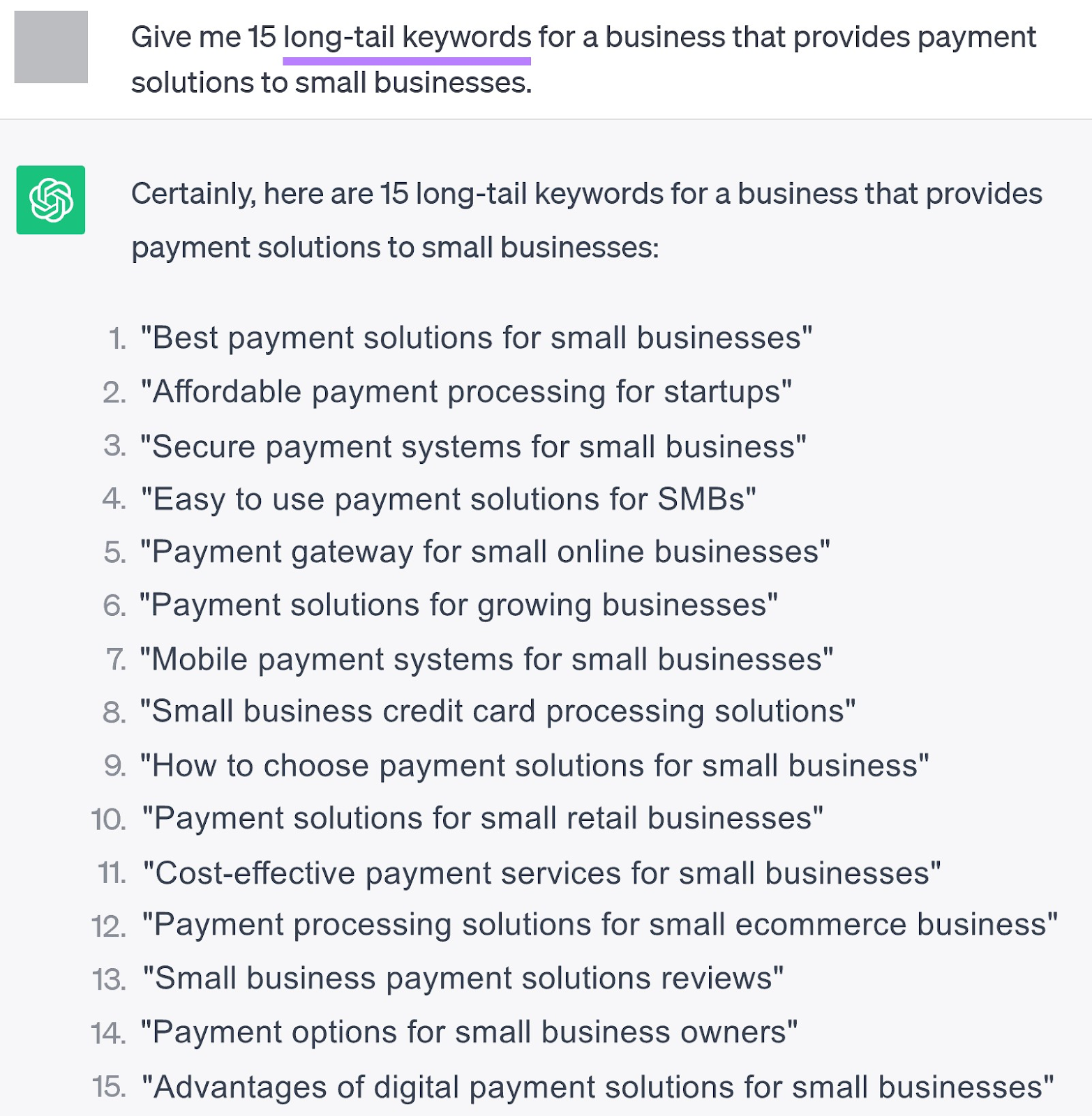
On its own, ChatGPT isn’t a keyword research tool. The free version can’t access live web pages, let alone offer useful data such as estimated search volume and keyword difficulty.
That means you’ll need to follow up the results with some research.
Let’s double-check our sample list on Semrush. Go to the Keyword Overview tool and input the list of keywords ChatGPT generated.
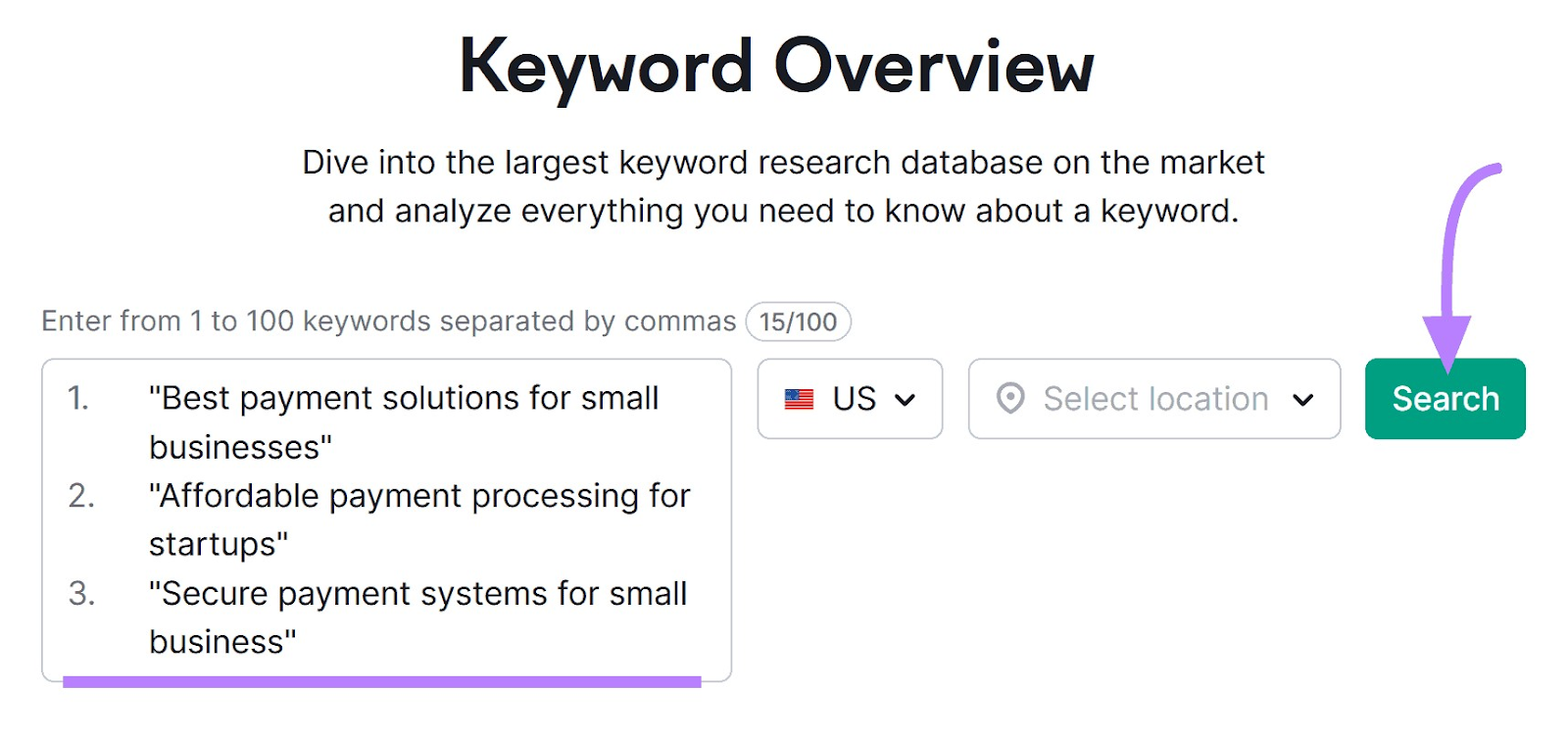
The bulk analysis shows that most keywords have very low search volume.
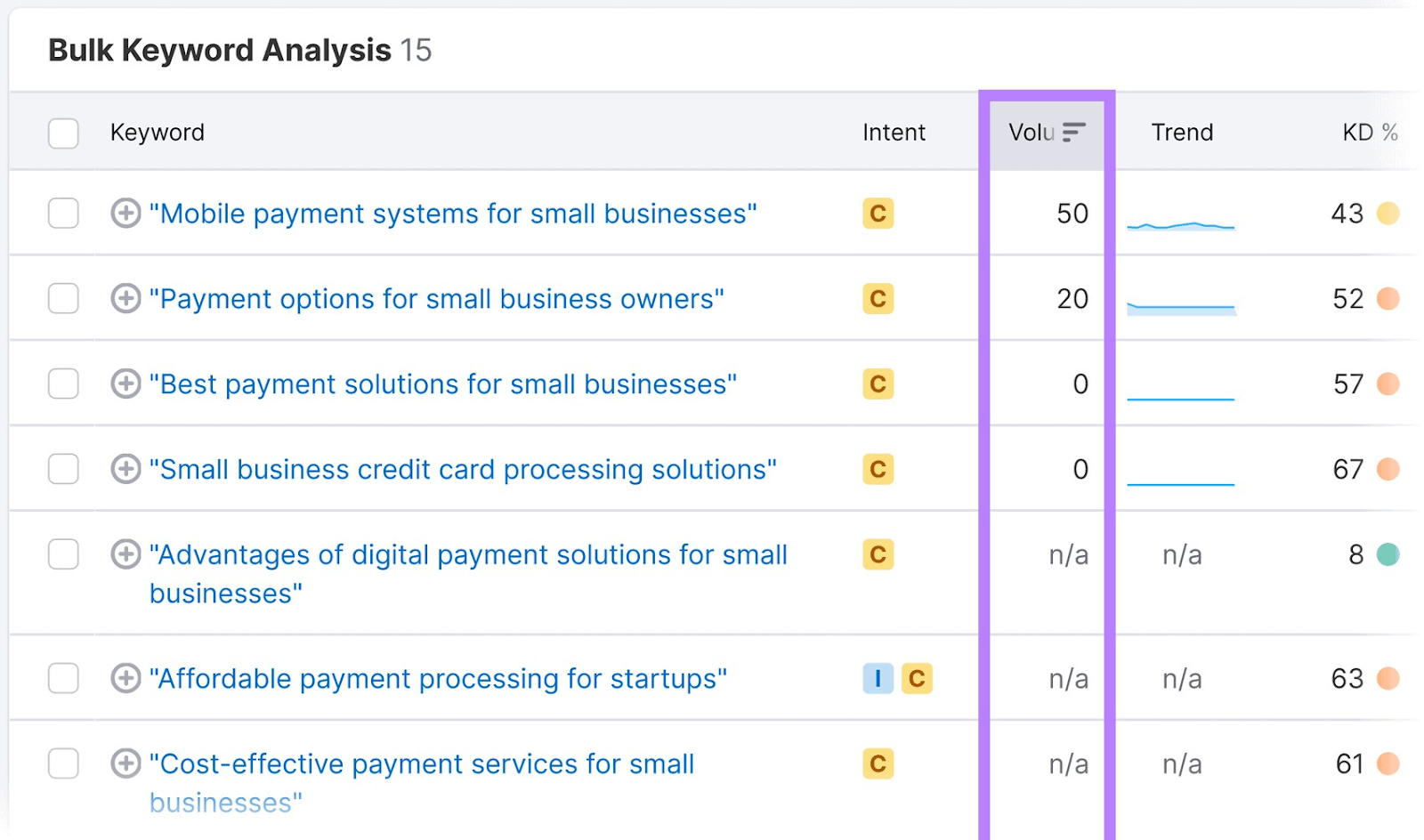
Clearly, we can’t base an effective content marketing strategy around the list we generated.
Instead, consider using ChatGPT’s outputs to provide one angle of your research. Then, complement that with comprehensive tools from Semrush.
For instance, you could do an in-depth analysis to refine your results.
Enter one of the keywords, like “best payment solutions for small businesses,” in Semrush’s Keyword Overview tool.

Semrush’s Keyword Overview tool gives you related keywords and keyword ideas you can analyze.
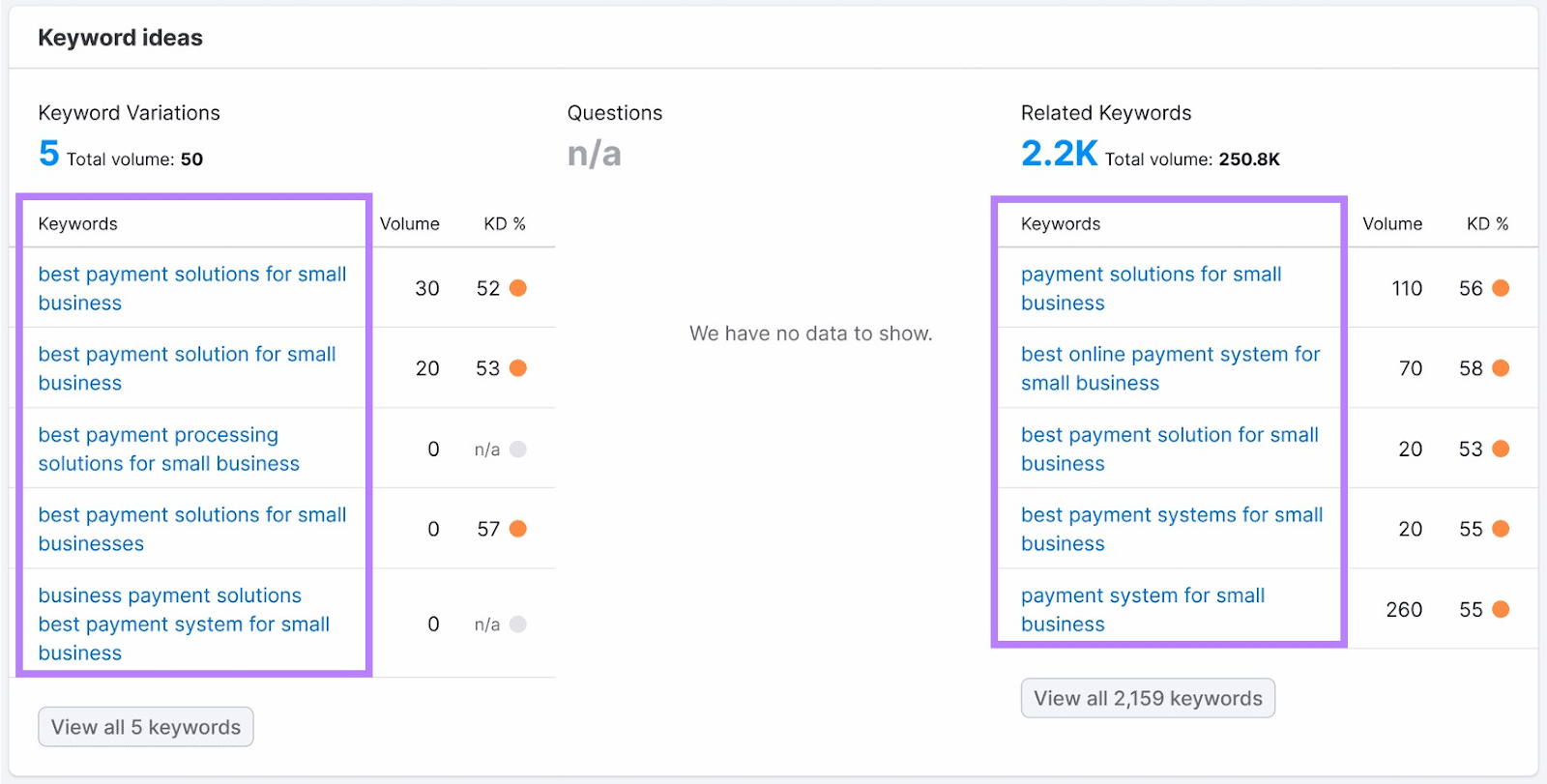
Click “View all” to see the full list of related keywords in the Keyword Magic Tool.
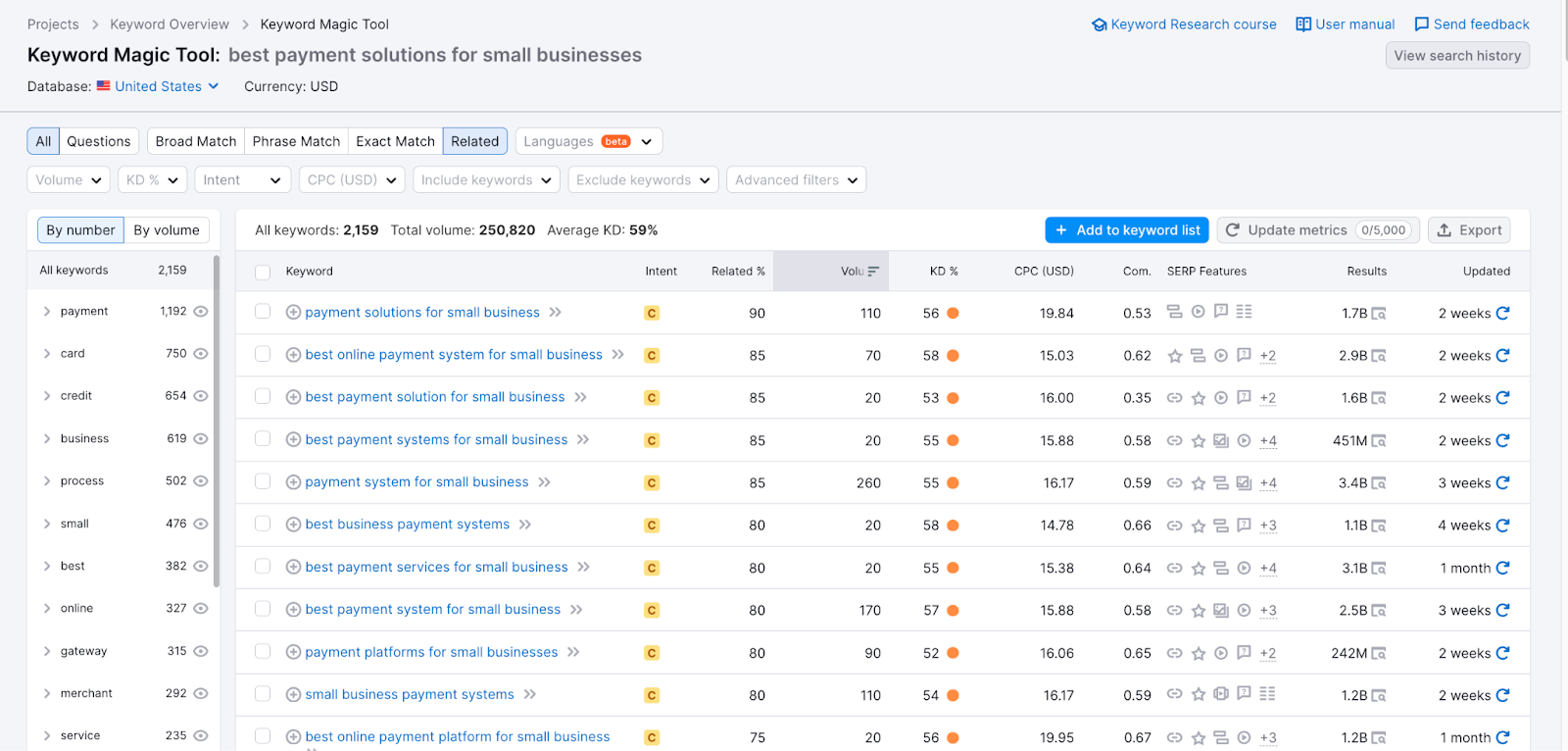
The Keyword Magic tool gives you keyword ideas as well as ranking difficulty for each of those keywords.
Playing around with both tools can give you keyword ideas. Although you can’t rely completely on ChatGPT’s output, you can use it to jumpstart your keyword research process.
2. Group Keywords Based on Semantic Relevance
Semantic relevance refers to how keywords relate to each other in terms of meaning or context. Grouping them helps you know which words to put together in a piece of content for better ranking. You can ask ChatGPT to classify a list of keywords based on semantic relevance.
When you optimize your content using semantically related keywords, you create a richer, more thorough context. This helps search engines understand search intent.
Here’s a prompt that helps you classify keywords:
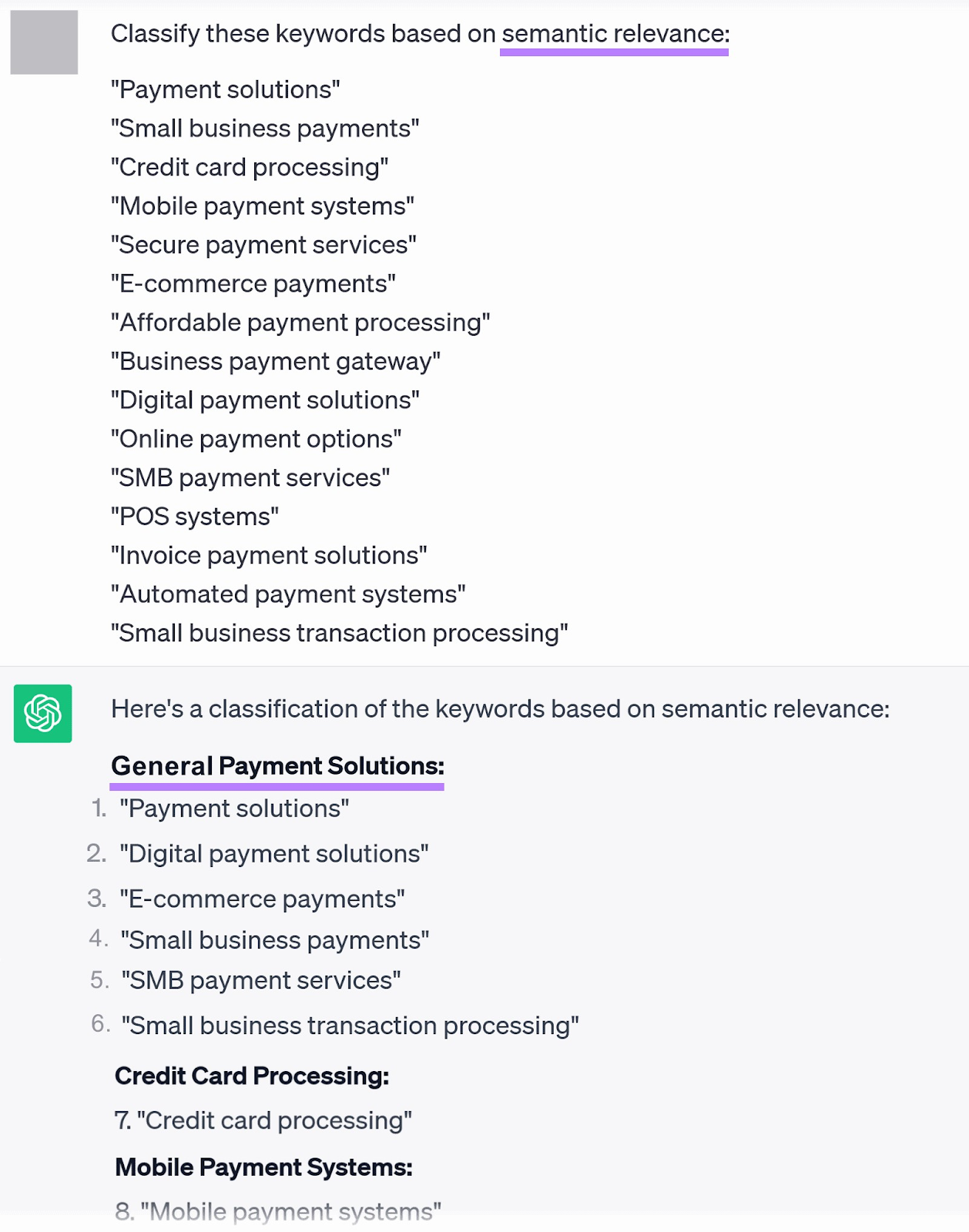
When you have your categories, you can use them as a foundation to build out a wide range of targeted, relevant content for your website.
For instance, take the “general payment solutions” category.
You can use these keywords to write articles about the importance of reliable payment solutions for small businesses.
You can also include them in comparisons of different general payment services. Or case studies showing how effective payment solutions have helped small businesses succeed.
3. Create Topic Clusters
Topic clusters are categories of related topics linked with one central “pillar” topic. They help users navigate your content and signal to search engines that your website has a high degree of authority on the subject.
Use ChatGPT to generate ideas for topic clusters to improve internal linking.
Say your company offers payment solutions for small businesses. You want to build topical authority on the keyword “buy now pay later (BNPL)” and create quality content around it.
Ask ChatGPT to give you topic cluster ideas for the keywords. Here’s an example:
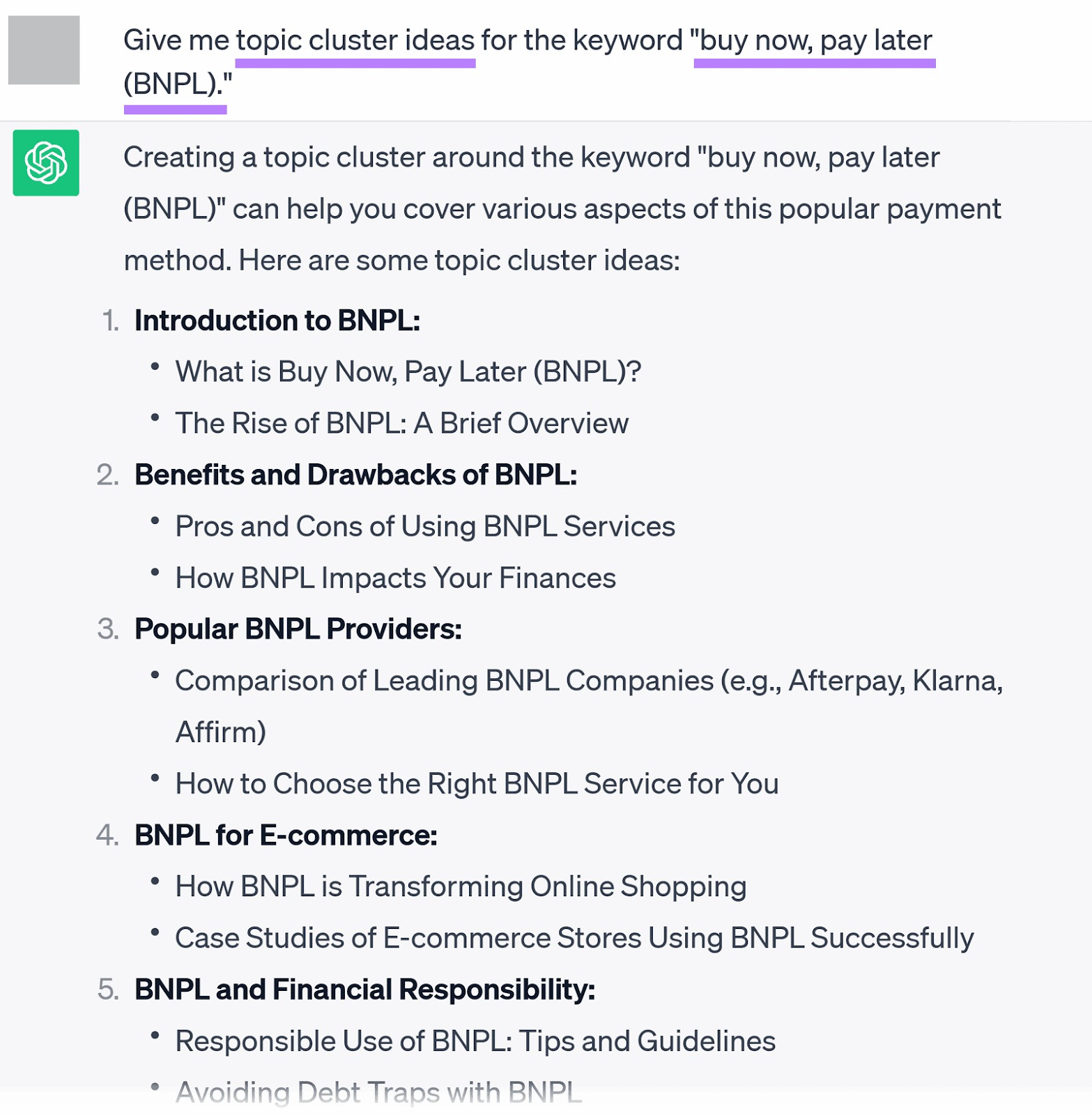
The result is a comprehensive list of topics to jumpstart your content strategy. From there, you can create pages for each topic, link them together, and include the BNPL keyword.
4. Generate Headline Ideas
Click-worthy headlines encourage readers to engage with your content. Provide ChatGPT with the headline’s keyword, character limit, and purpose to generate headline ideas.
On average, eight out of 10 people will read your headline copy, but only two out of 10 read the rest.
Here’s how you can use ChatGPT to generate attention-grabbing headline ideas that can help inspire people to engage with your content:
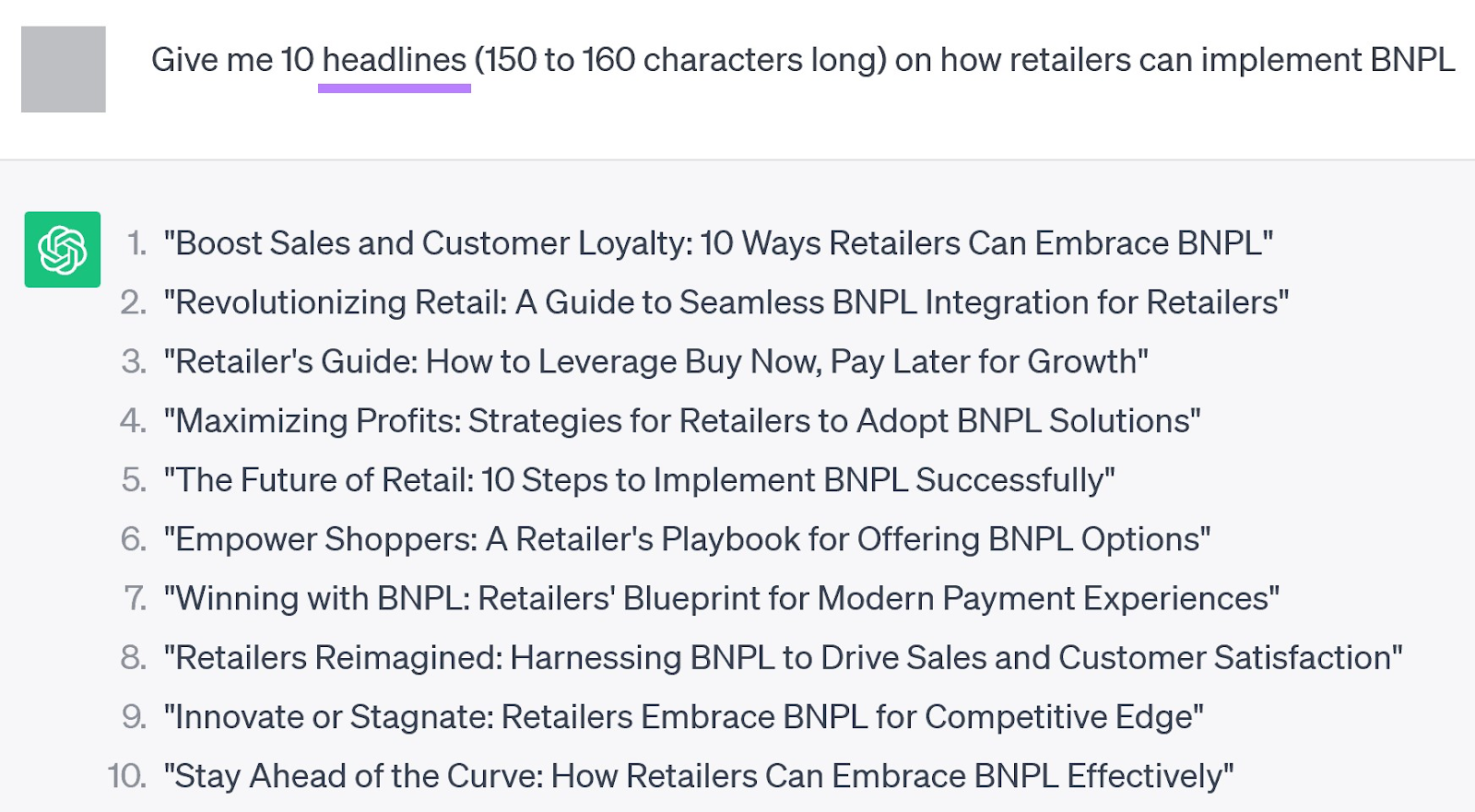
You can include more specific prompts to boost your headlines’ effectiveness:
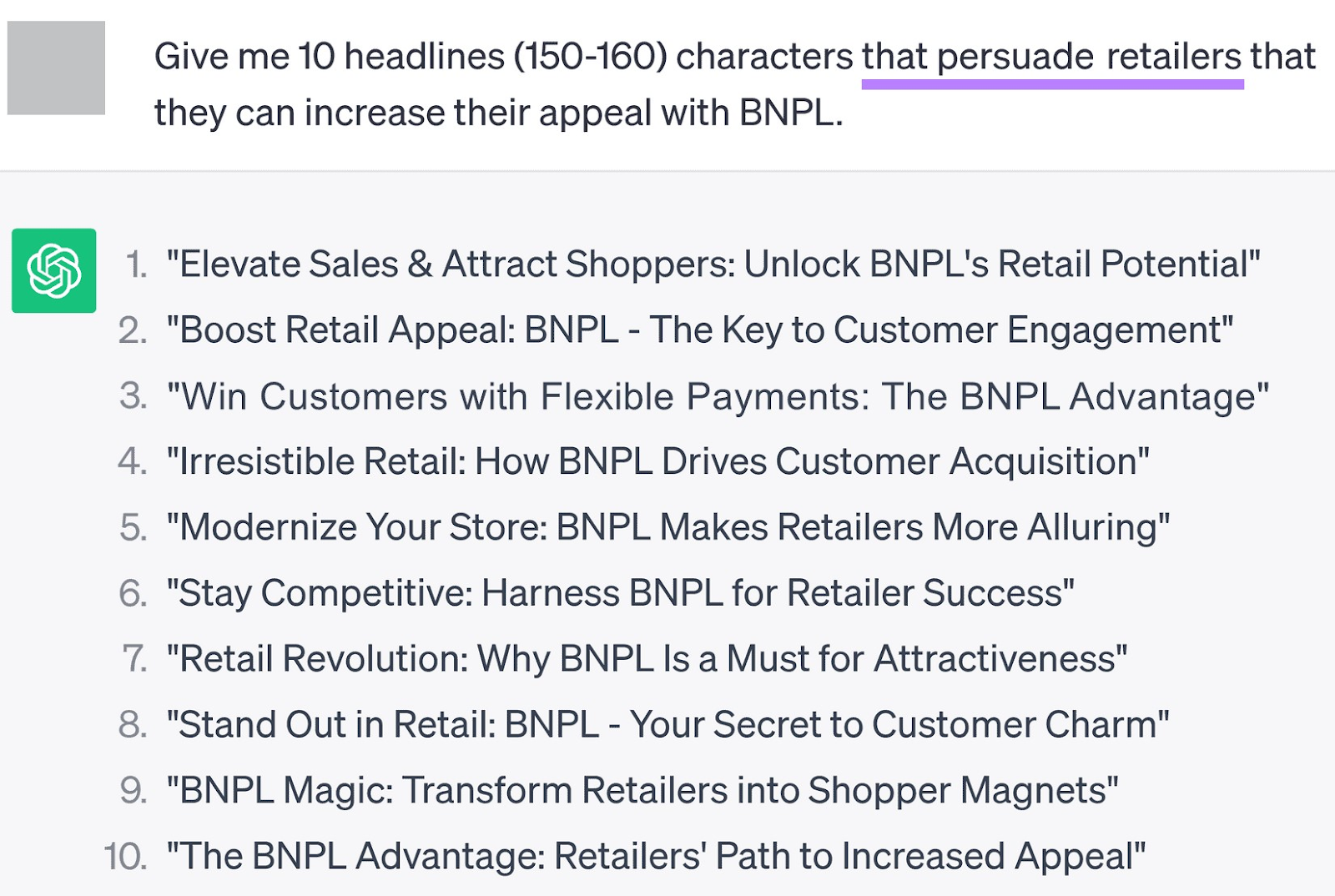
These headlines provide a starting point and use emotionally charged words that resonate with your target audience.
Further reading: How to Write SEO Headlines That Rank (+ 9 Powerful Templates).
5. Craft Content Outlines
Use ChatGPT to create an article outline. Supplement the output with your research to flesh out the details and add a unique perspective to your content.
A ChatGPT outline can be a strong foundation for your blog post and guides you through the key points you want to cover. You can then adapt the suggested outline to suit your particular needs and writing style.
For example, let’s ask ChatGPT to generate an outline for one of our headlines, “Win Customers with Flexible Payments: The BNPL Advantage.”

This is a good start. Now, it’s up to your judgment and expertise to evaluate how well this blog would work.
For example, you could combine the headings “The BNPL Advantage” and “Case Studies of Successful BNPL Implementation.” You can find case studies that fit into each of the benefits of BNPL to support them.
The subtopics “Steps to implement a BNPL system” and “Choosing the right BNPL provider,” on the other hand, are meaty and may be better off as separate articles.
6. Create Content
Use AI to aid your writing process and speed up content creation. Supplement ChatGPT with your expertise and research to create engaging, informative content.
For example, let’s ask ChatGPT to generate an article on “Win Customers with Flexible Payments: The BNPL Advantage.”
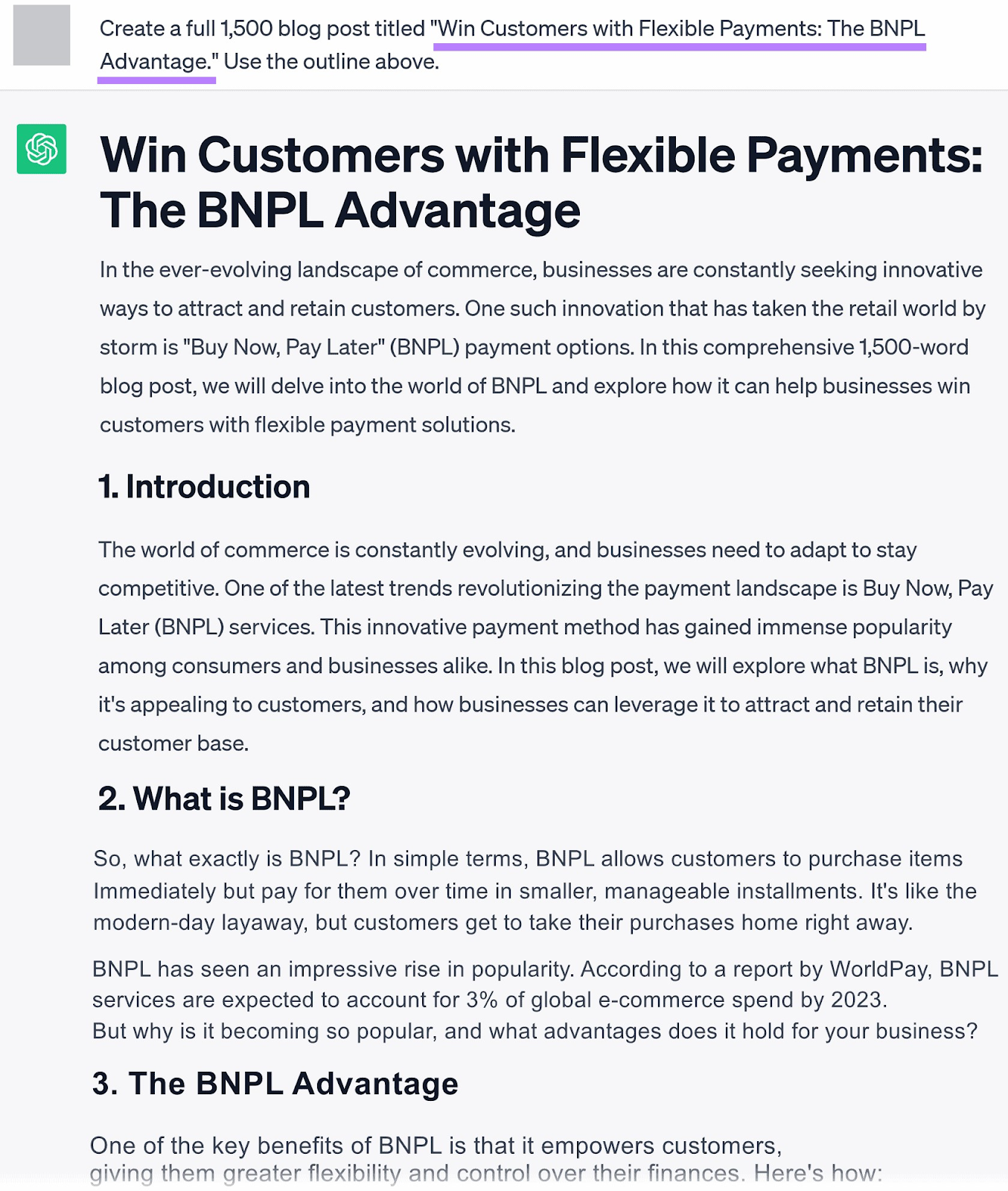
Unfortunately, the output is quite thin. It doesn’t have any personality or offer a unique perspective.
To get more valuable, in-depth content from ChatGPT, you can break up the article into chunks and address each section individually.
For example, you may decide you want to incorporate storytelling into your introduction to create an emotional connection with your reader.
You can prompt ChatGPT to use storytelling by adding examples or hypothetical scenarios to your prompt. For instance:
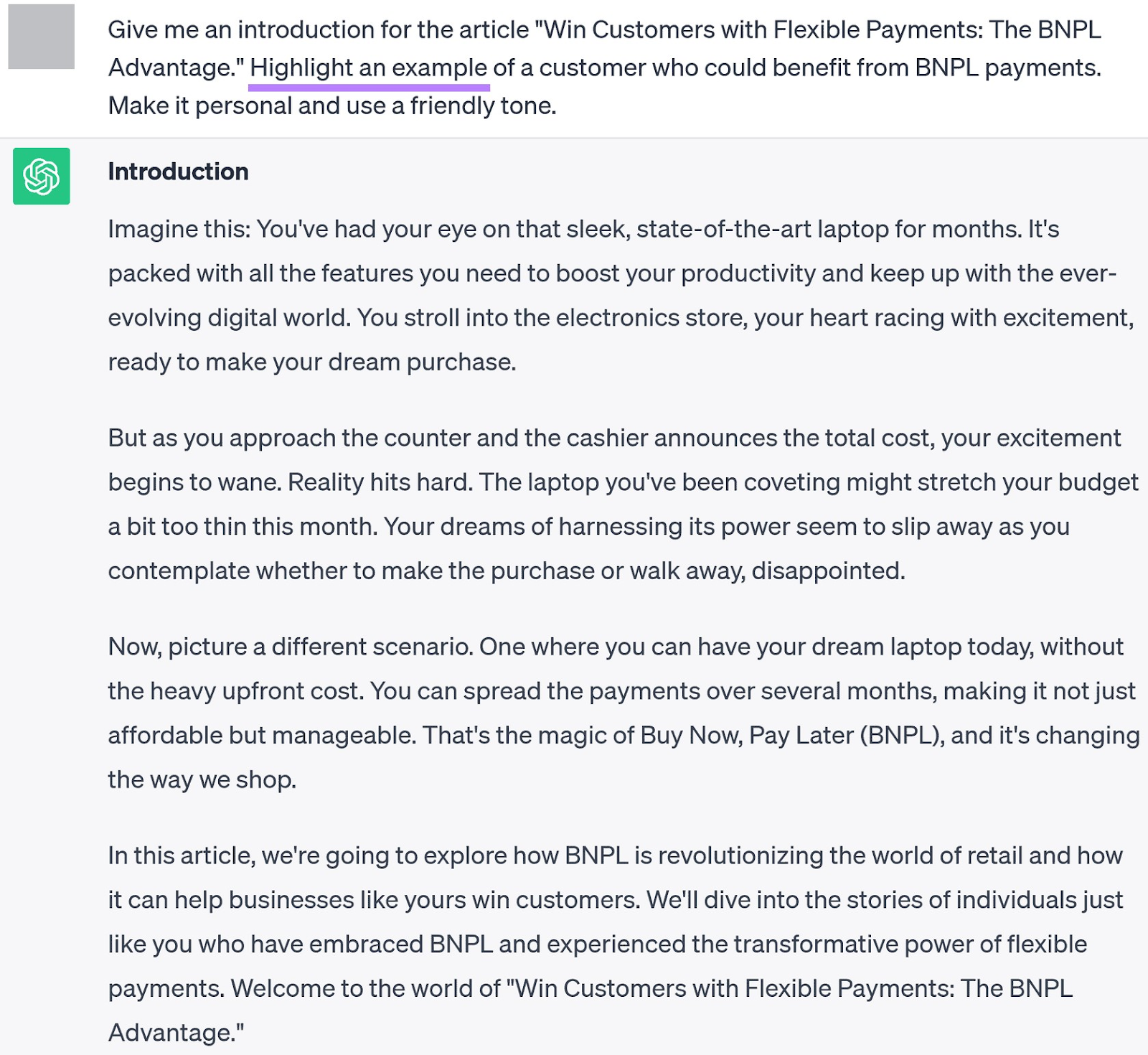
This AI-generated content has more personality than the previous one. Although it still needs edits, it serves as a decent foundation.
Note: AI-generated content can’t demonstrate E-E-A-T, which stands for Experience, Expertise, Authority, and Trustworthiness. Although not a direct ranking factor, Google uses these elements to determine the overall quality of a page.
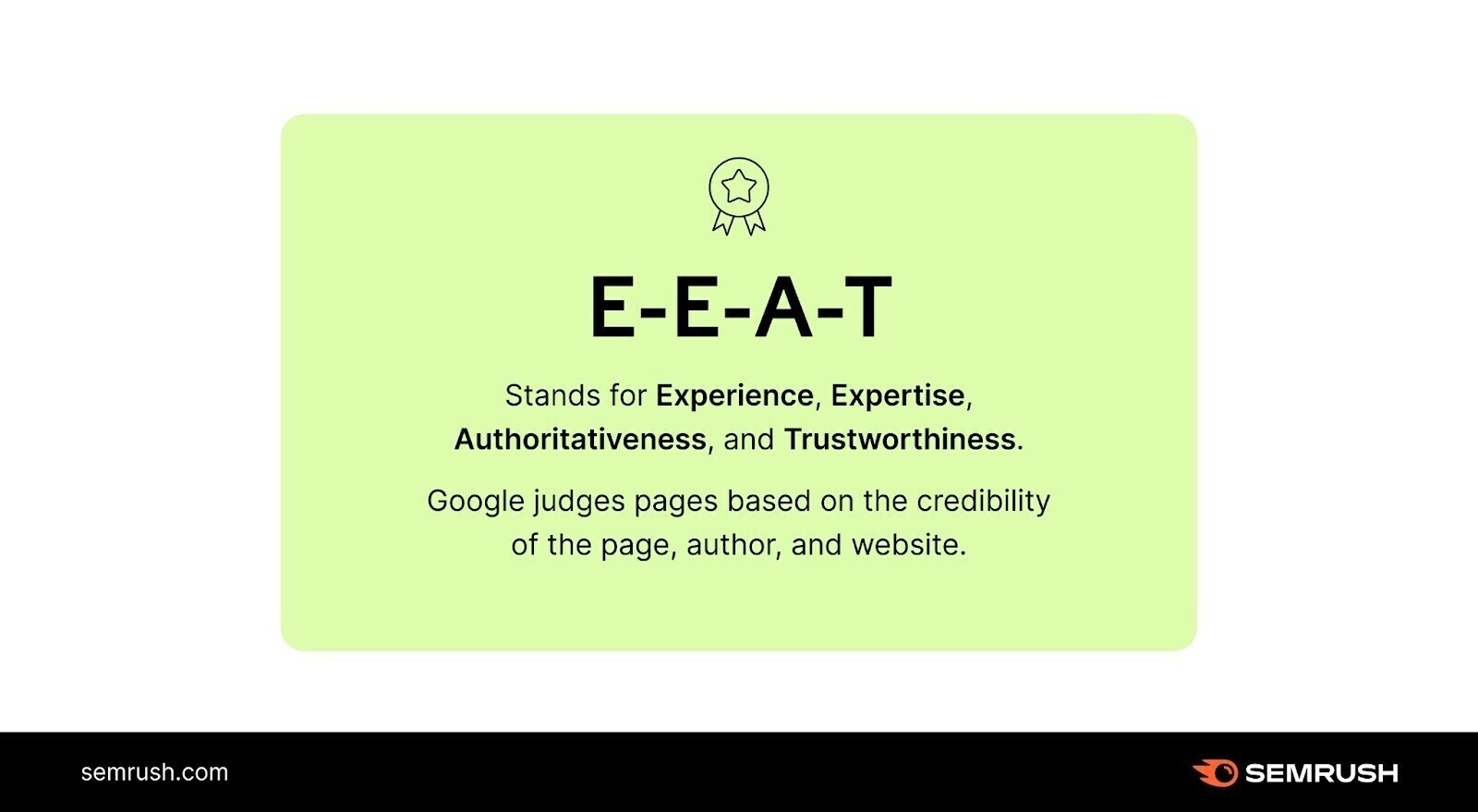
Lastly, quotes from subject matter experts add a unique perspective to your content.
You can connect with relevant experts on LinkedIn or use websites like HARO and Help a B2B Writer that connect journalists and content creators with subject matter experts.

7. Identify Websites for Guest Post Outreach
Expedite finding sites for guest blogging and improve link building by asking ChatGPT to give you a list of blogs within your niche.
Backlinks are one of Google’s top three ranking factors, and guest posts help you build authority in your niche. These backlinks signal to search engines that your website is valuable and trustworthy.
Create a prompt describing what your business does and who your target audience is. Then, instruct ChatGPT to provide a categorized list of related sites.
For example:
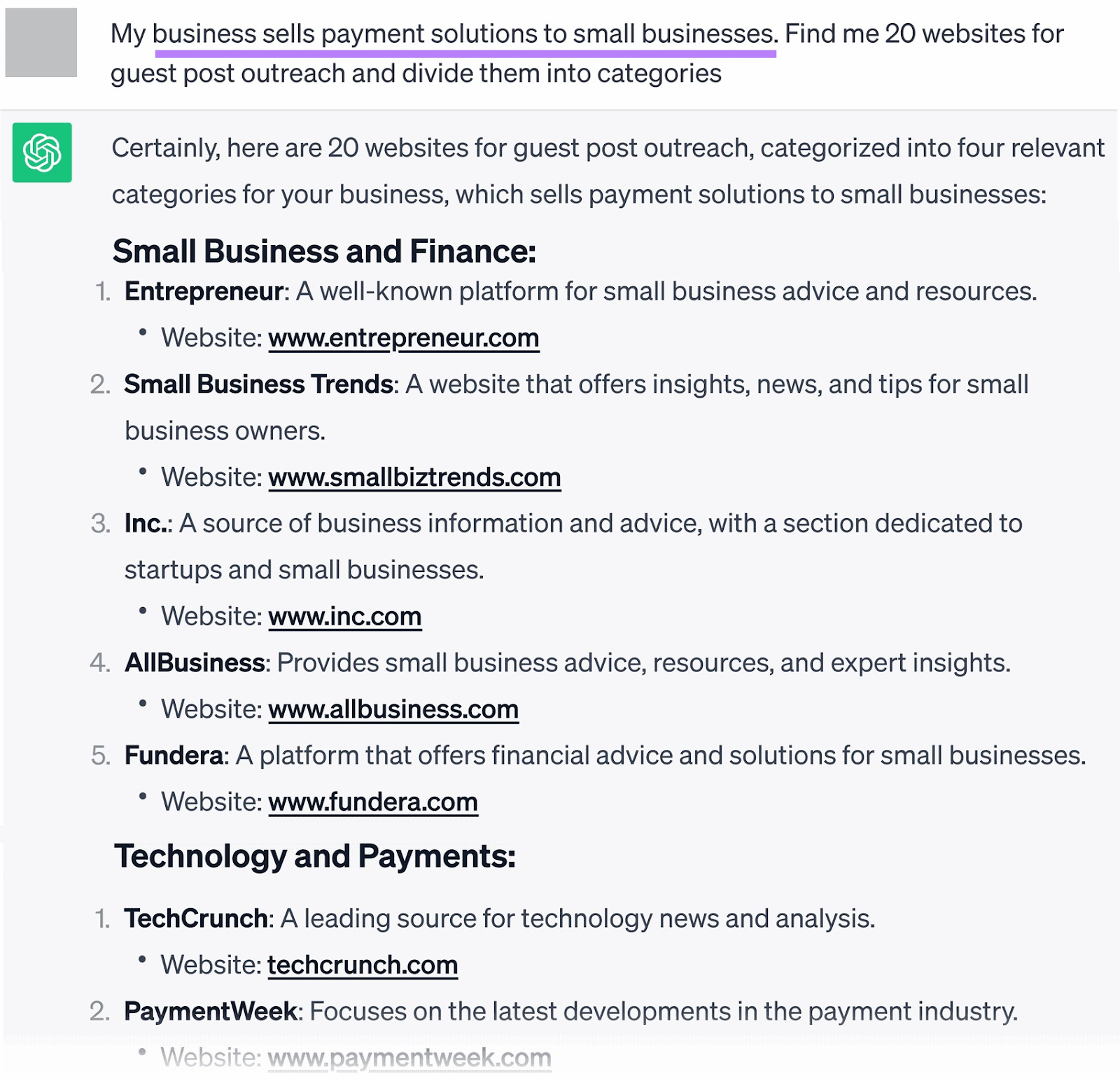
Note the disclaimer about ChatGPT’s data limitations. You always need to double-check any output to ensure these websites are still functional and that they accept guest posts.
You can ensure up-to-date results using Semrush’s Link Building tool.
It analyzes your competitors’ profiles to find the top sources generating backlinks in your niche. You can add these to your list and then use ChatGPT to help with your outreach.
When you have a categorized list, you can also ask ChatGPT to generate a friendly outreach email template for each category.
Here’s an idea of what you can do:

This is a good start, but you should personalize your message beyond what ChatGPT can provide.
For example, by referencing a specific blog you liked or even a LinkedIn or Tweet the editor posted.
This shows the recipient you know something about them and their work. Input your personalized template into the Link Building tool, which will send and track responses.
8. Generate Structured Data
Structured data, or “schema markup,” is a code language search engine crawlers use to better understand the information on the page.
When search engines recognize the schema markup on your page, they serve rich results, or rich snippets. For example, a search for the “best pizza in New York” gives this result:
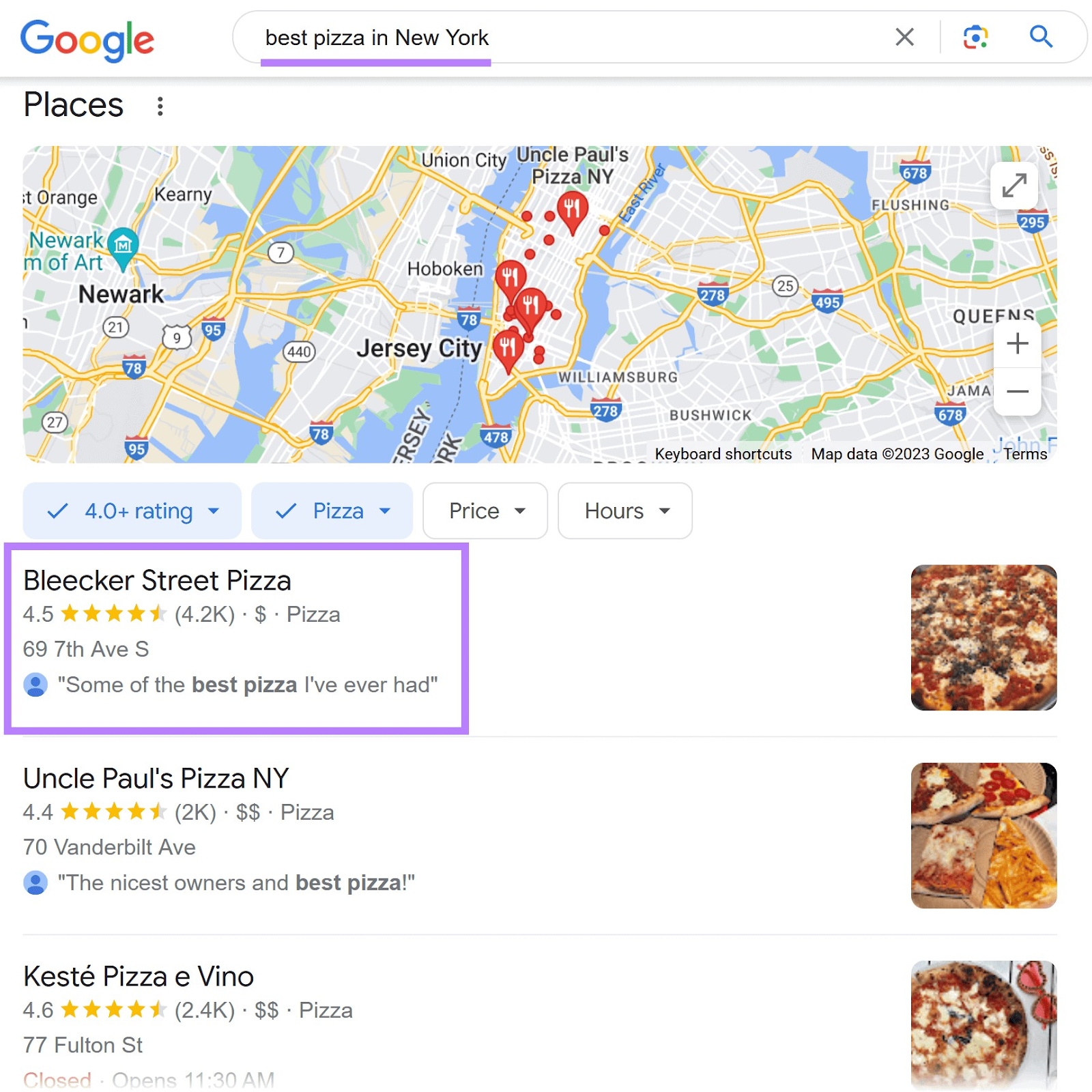
Schema markup provided the data in the snippet. It populates search results with useful information, including locations, reviews, cuisine, and price points.
You can ask ChatGPT to generate schema markup to add to your website’s code.
For example, here’s how it creates a menu schema for Magnolia Bakery:
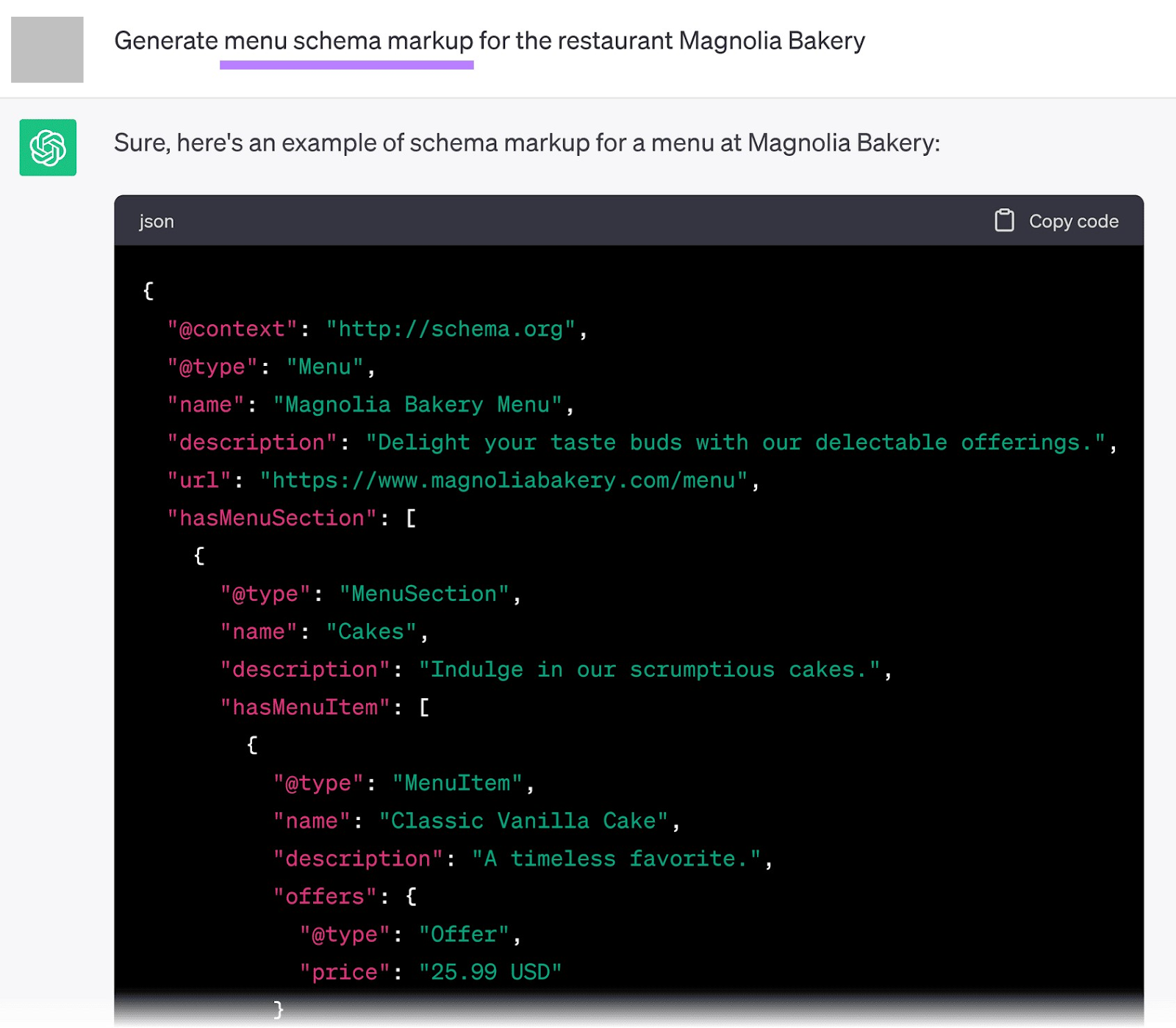
To use the code, you would simply replace the placeholder URLs with the URLs for each menu item on Magnolia’s website. Then adjust names and prices as needed.
Once you’re done, you can use a tool like Site Audit to test your entire site for schema markup issues.
9. Automate Meta Description Writing
Meta descriptions are short summaries of web pages that appear in SERPs. They provide search engines and users with a summary of the content, potentially improving click-through rates from search results.
You can use ChatGPT to generate meta descriptions by providing details like the keyword, primary topic, and character length.
Let’s implement it for our payment solution example with the keyword “small business payment solutions.”
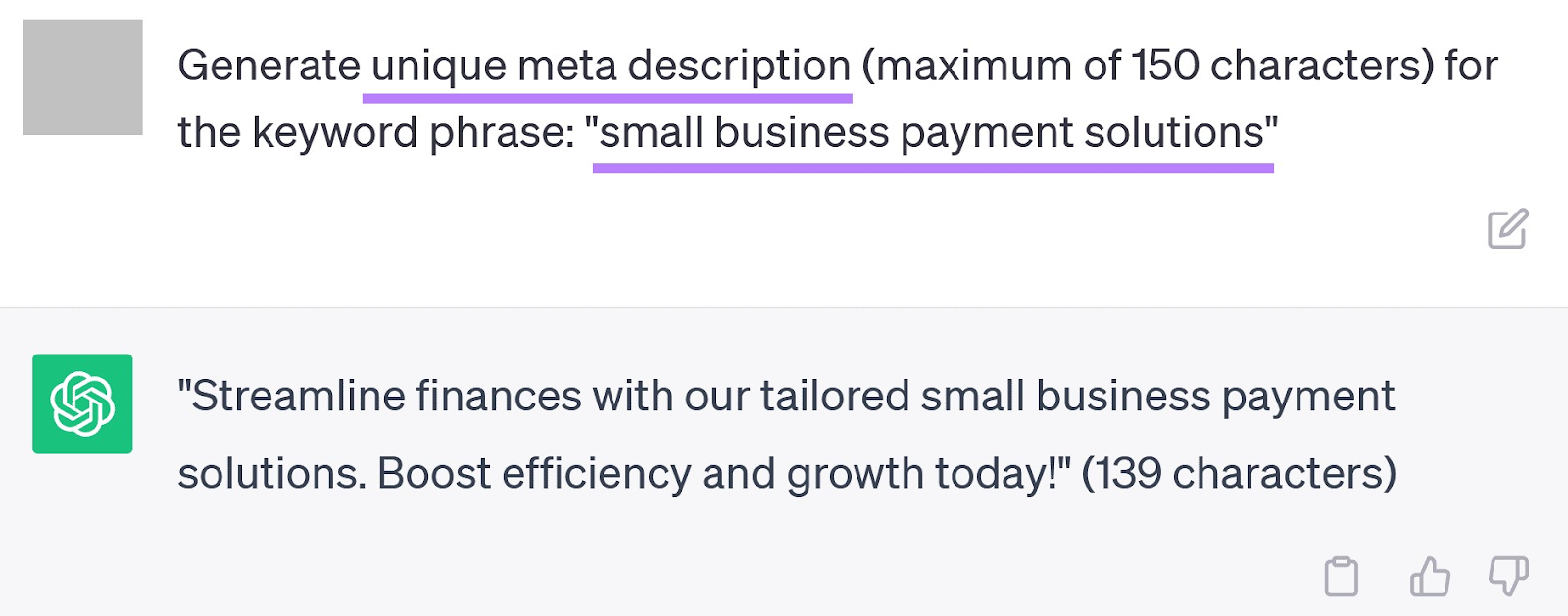
This meta description is a great start. You can also adjust the prompt if you need a meta description for a specific page, like a blog. For example:
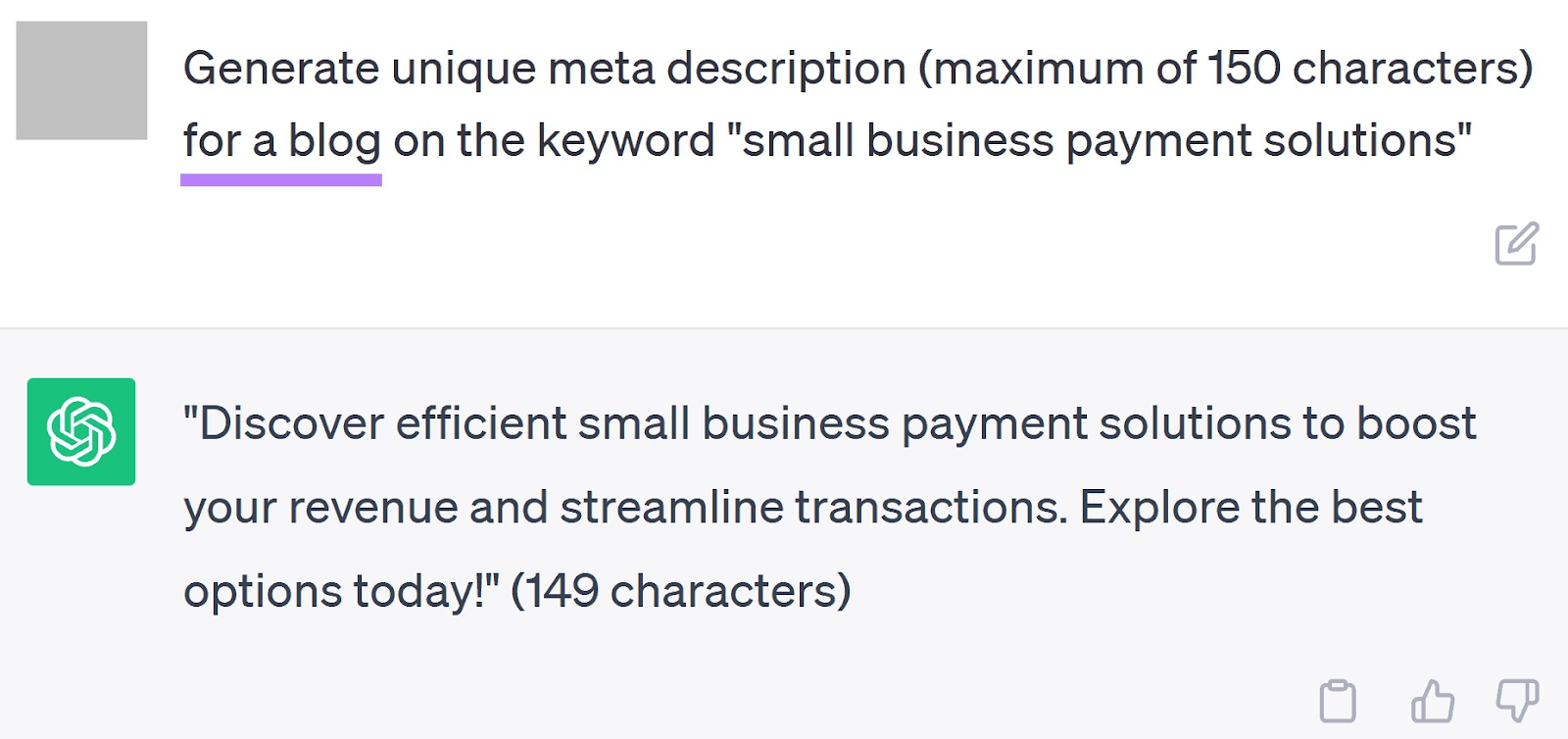
Always tweak the output based on your judgment. Infuse it with your brand voice and add any unique product benefits you’d like to highlight.
10. Write Meta Tags
Meta tags are HTML elements that provide search engines with information about the webpage. They include page title, author, description, and keywords.
Think of meta tags as your website’s first impression on search engines and potential visitors.
They give search engines a quick summary of your page’s content and help them categorize it properly.
Plus, well-crafted meta tags can pique a user’s interest, boosting your click-through rates and overall visibility.
For ChatGPT to craft click-worthy meta tags, give it some background on best practices first, then ask it to generate title tags for your chosen keyword. Here’s the prompt and the result:
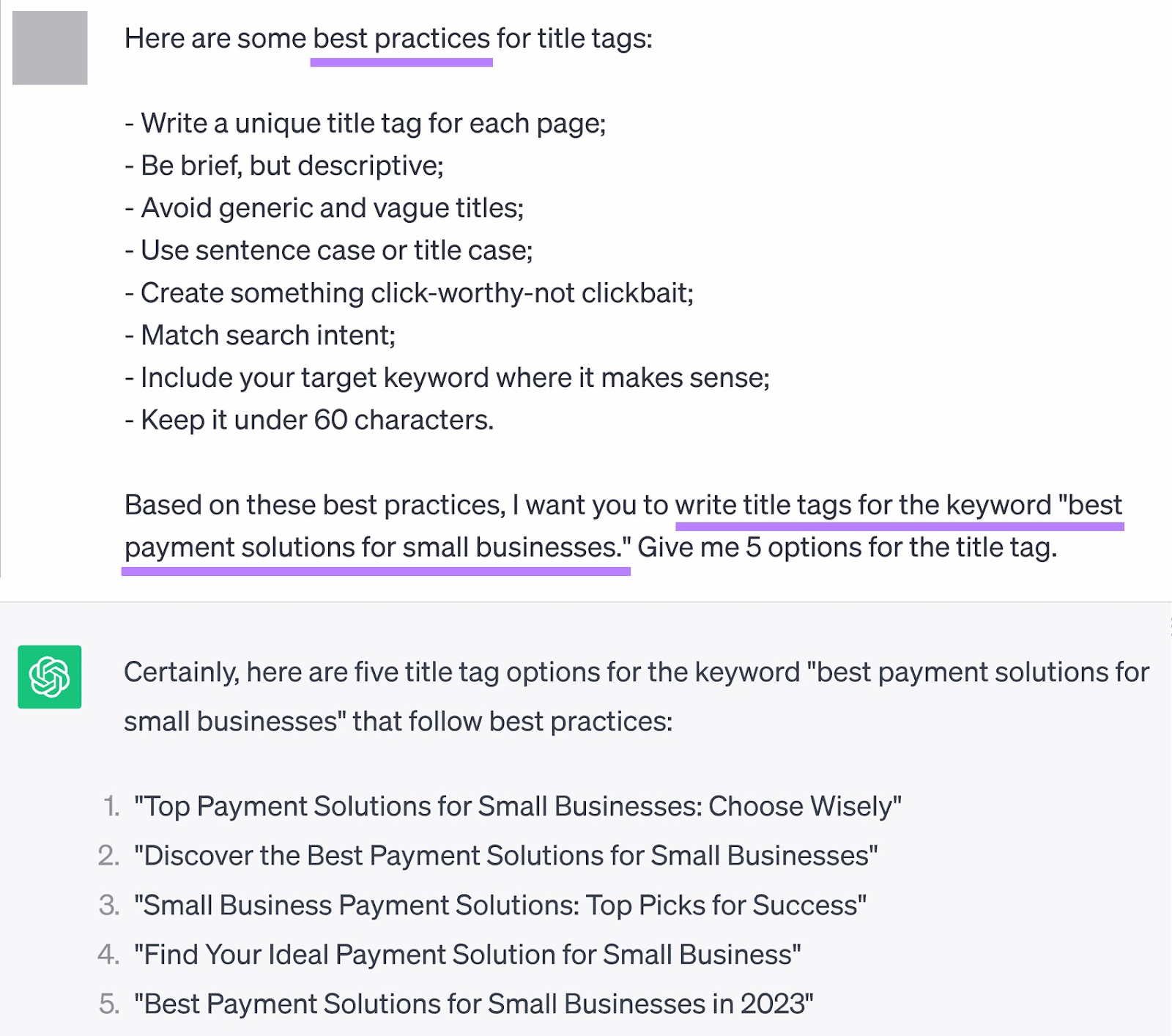
You can also ask ChatGPT to rewrite a competitor’s title tag. Rewriting existing tags can help you optimize your own title tags for better relevance, readability, and click-through rates.
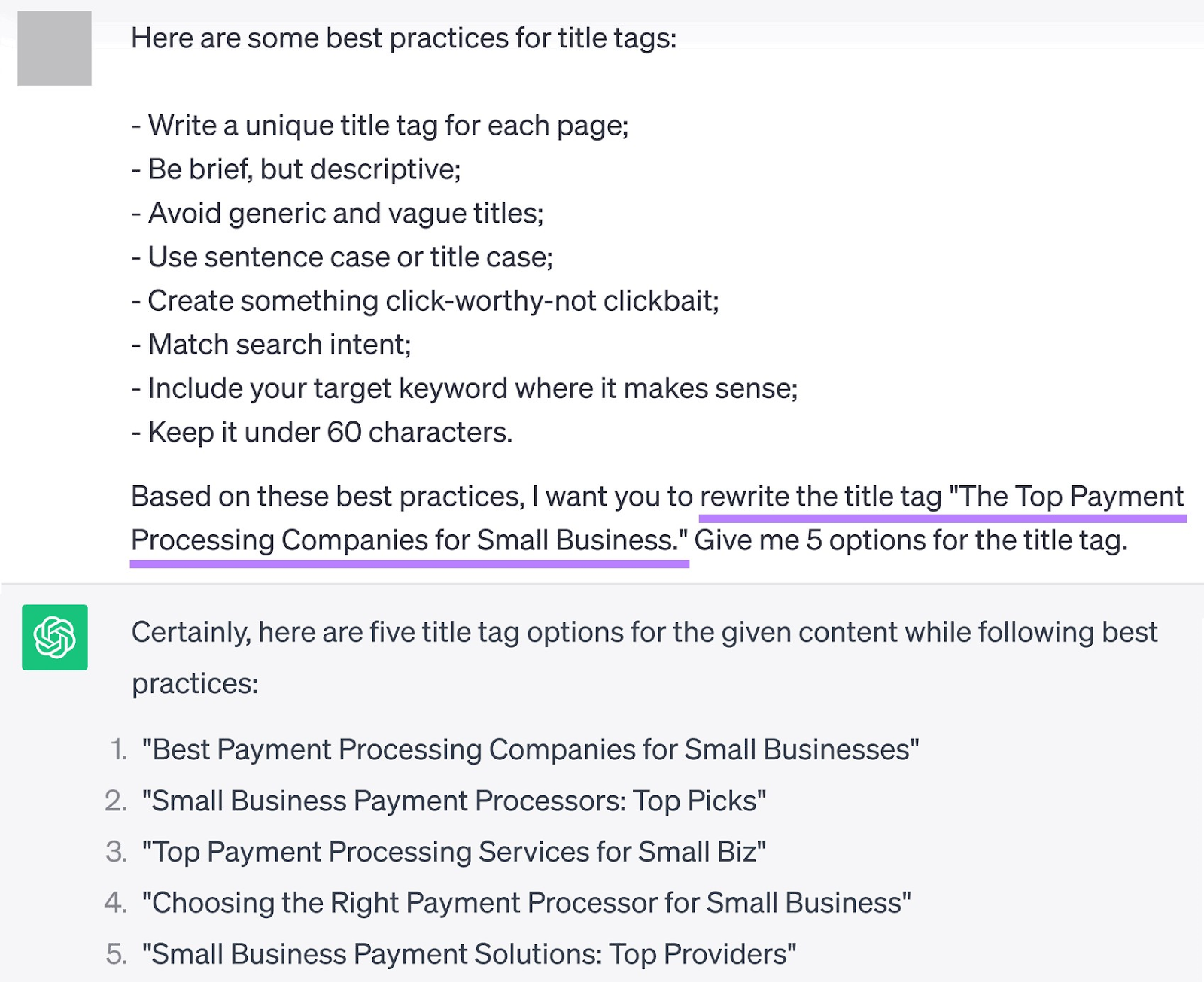
11. Create Crawl Directives for Robots.txt
A robots.txt file is a set of instructions for web robots, also known as crawlers or spiders.
It’s like a guide posted at the entrance of your website saying, “Hey robots, feel free to explore this part, but please stay away from that area over there.”
These files instruct bots toward valuable content and prevent them from accessing irrelevant or non-informative pages (like admin or login pages).
You can use ChatGPT to edit your robots.txt file and create rules. Here’s an example of a prompt you can use to develop rules for crawlers:
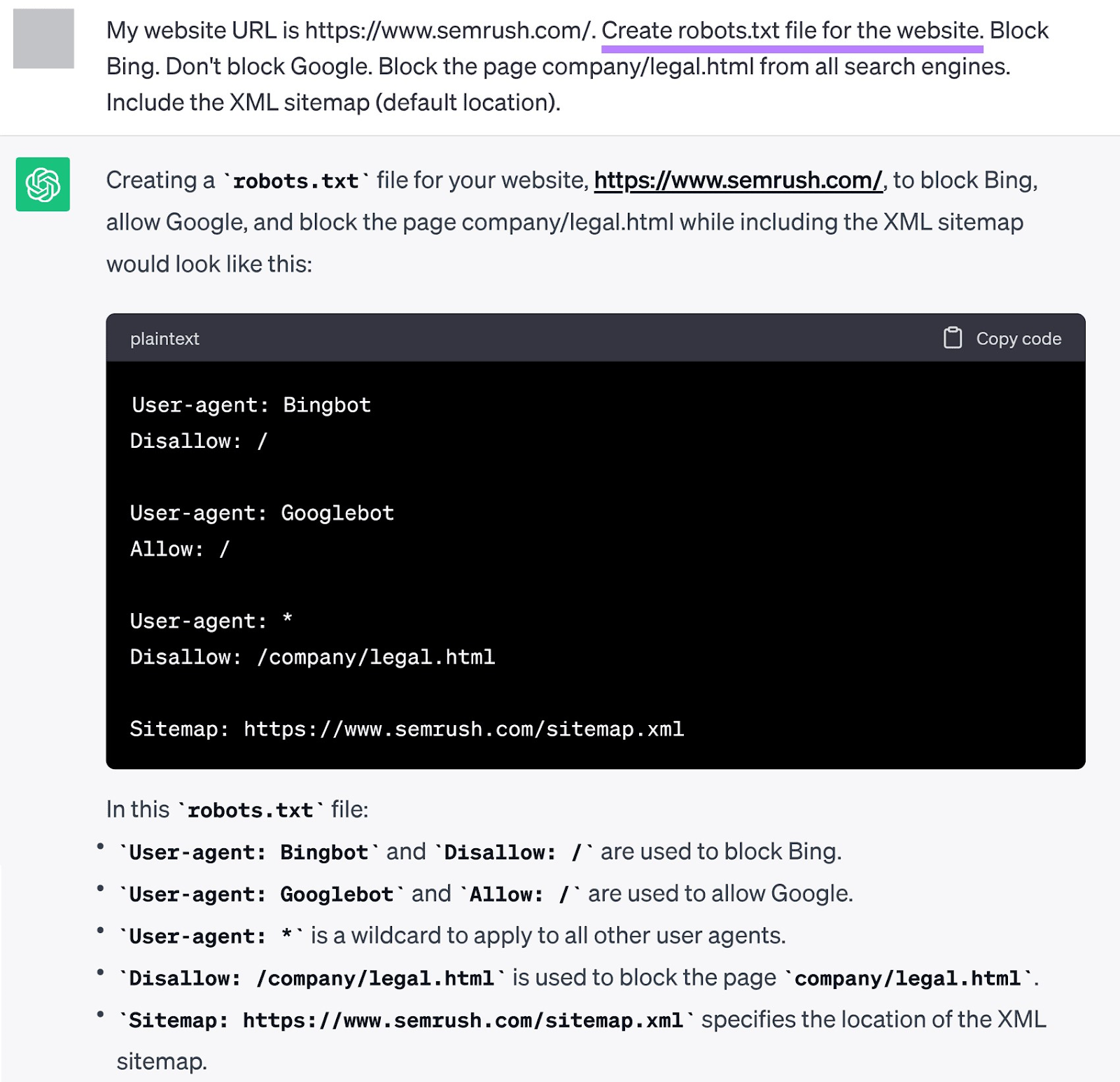
When creating a robots.txt file, be mindful of what you’re blocking. You don’t want to accidentally block search engines from important pages, which will harm your website's visibility.
Also, always verify your file’s syntax and location. Even small errors could significantly affect how bots crawl and index your site.
12. Create Regular Expression (Regex) Patterns
Regex, short for regular expressions, is a sequence of characters that forms a search pattern.
You can use this pattern to match, locate, and manage text. This makes for better log file analysis, improved website crawling, and enhanced Google Analytics reporting.
Think of it like a super-powered version of “Find and Replace” in a text document, but with a lot more flexibility and precision.
Say you want to find keywords that include “credit card,” “debit card,” “payment processing,” or “wire transfer” in them. Here’s what you can tell ChatGPT:
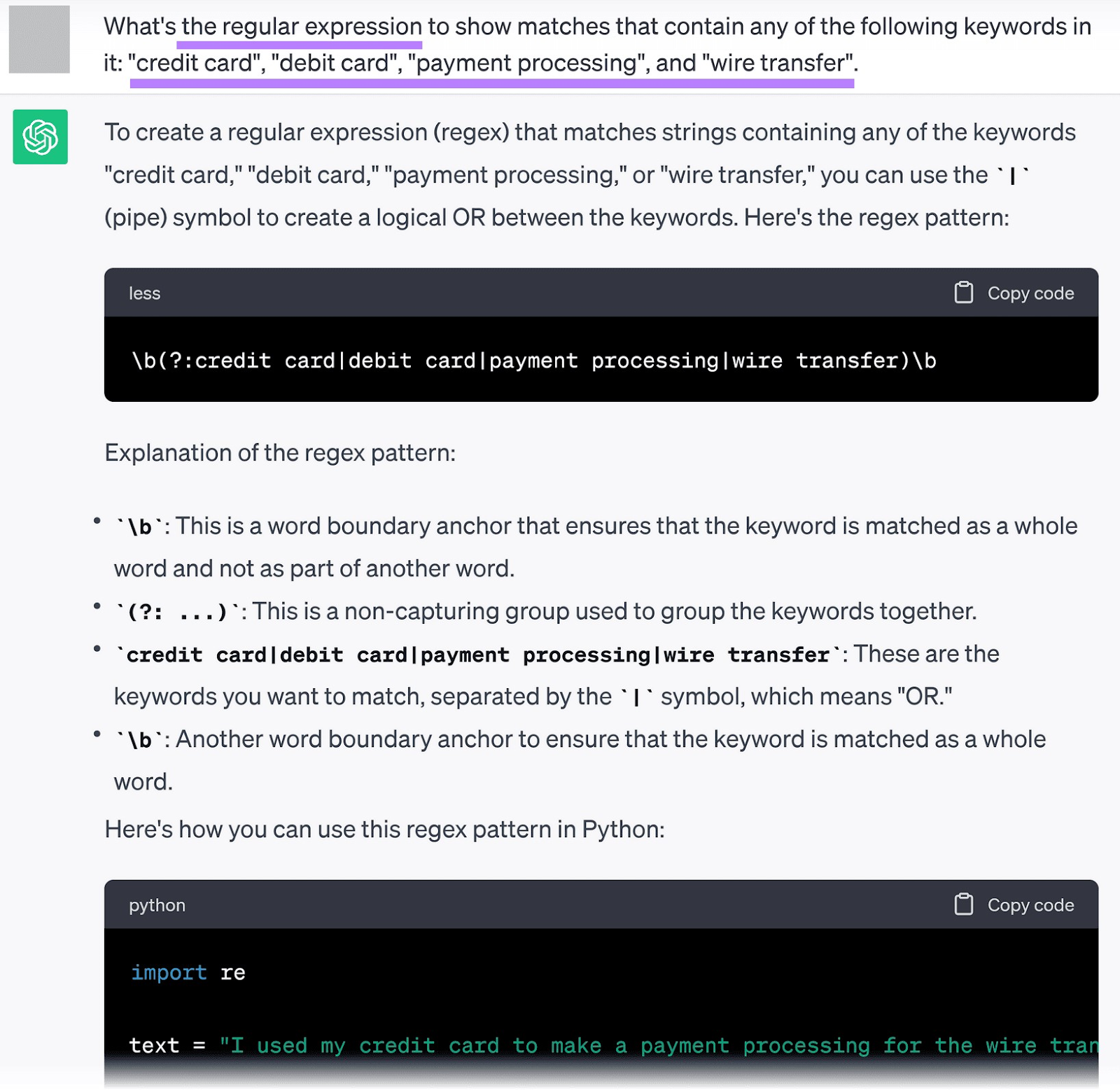
Next, go to Google Search Console and paste the custom regex in the Query filter.
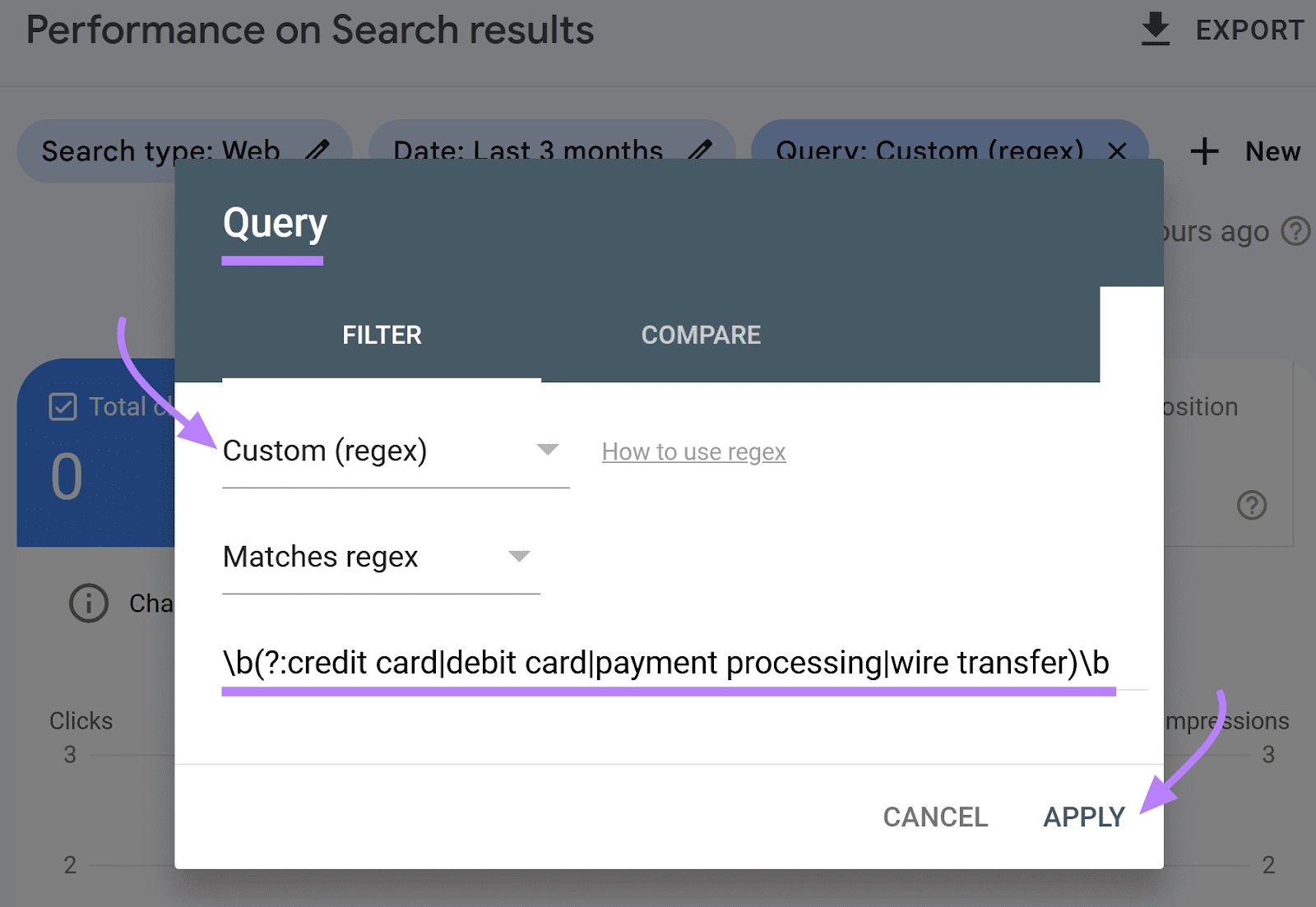
You’ll get a list of the keywords that include all or part of those terms and their rankings.
Arrange the list in ascending order to see which keywords aren’t ranking well. You can work on optimizing these keywords by including them in more content and improving their search engine rankings on Google.
13. Generate Sitemaps
A sitemap is a blueprint of your website that helps search engines find, crawl, and index all your website’s content. It’s a file that lists your site’s web pages and informs search engines about the organization of your site content.
Sitemaps are especially important if your site is large, has many external links, or has a large archive with pages not linked to each other.
To create an XML sitemap with ChatGPT, you need to create a list of URLs to include. Like this:

ChatGPT returns a sitemap along with an explanation of what each of the properties means.
You also get valuable metadata associated with the pages you list in the sitemap. Like information about when the page was last updated, how often the page is changed, and its prioritization on your site.
This metadata can give search engines a better idea of how to crawl your site.
14. Use Plugins
ChatGPT plugins improve the functionality of the basic tool. There are plugins that help you with everything from keyword research to SEO analysis.
For example, you can access external databases or APIs to pull in real-time data or information OpenAI didn’t include in ChatGPT’s original training. You can also perform SEO analysis, keyword exploration, and language translation.
To access plugins, you need to sign up for ChatGPT Plus, the paid version of the tool.
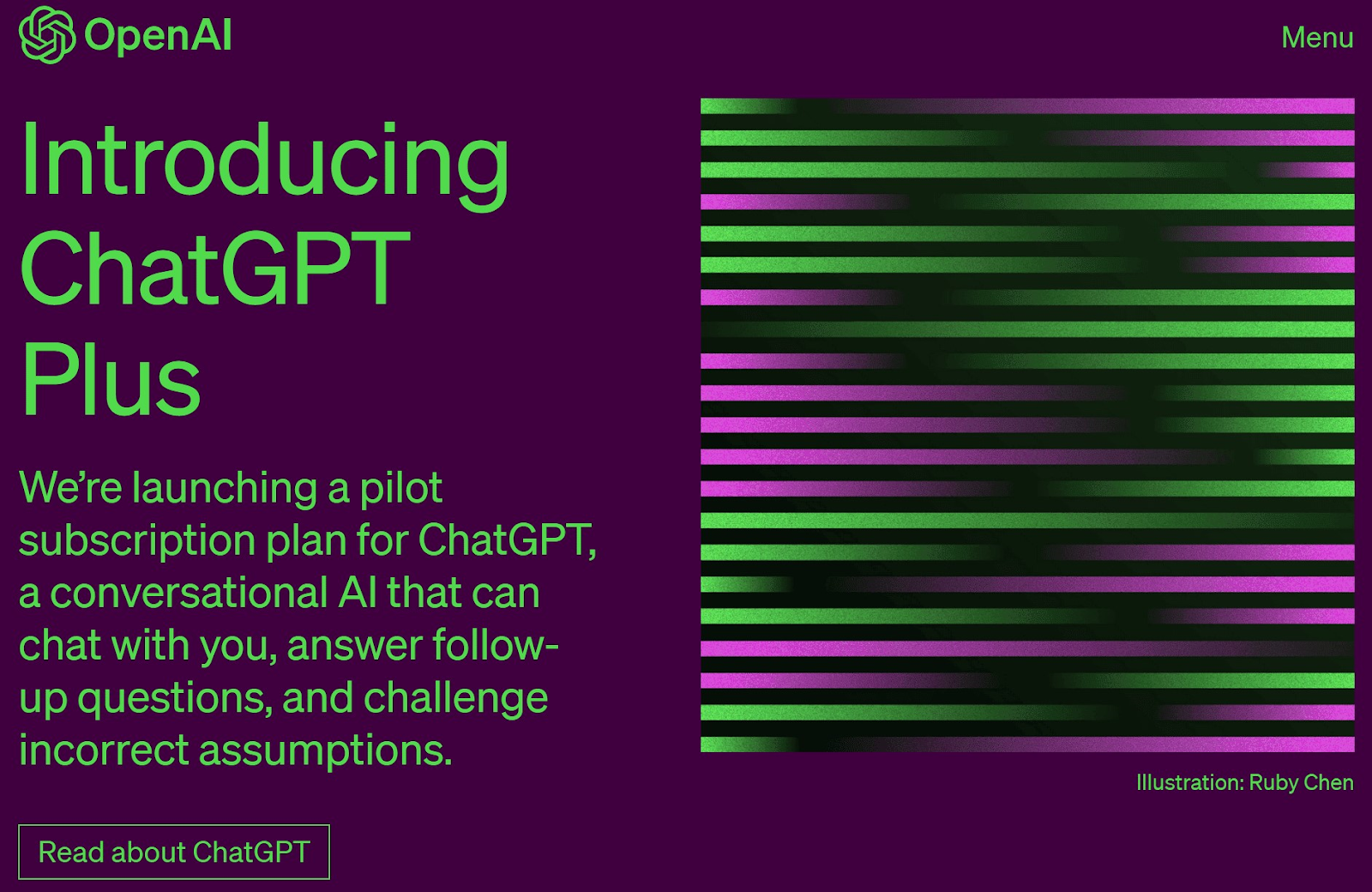
When you sign up, go to settings and enable the beta features.
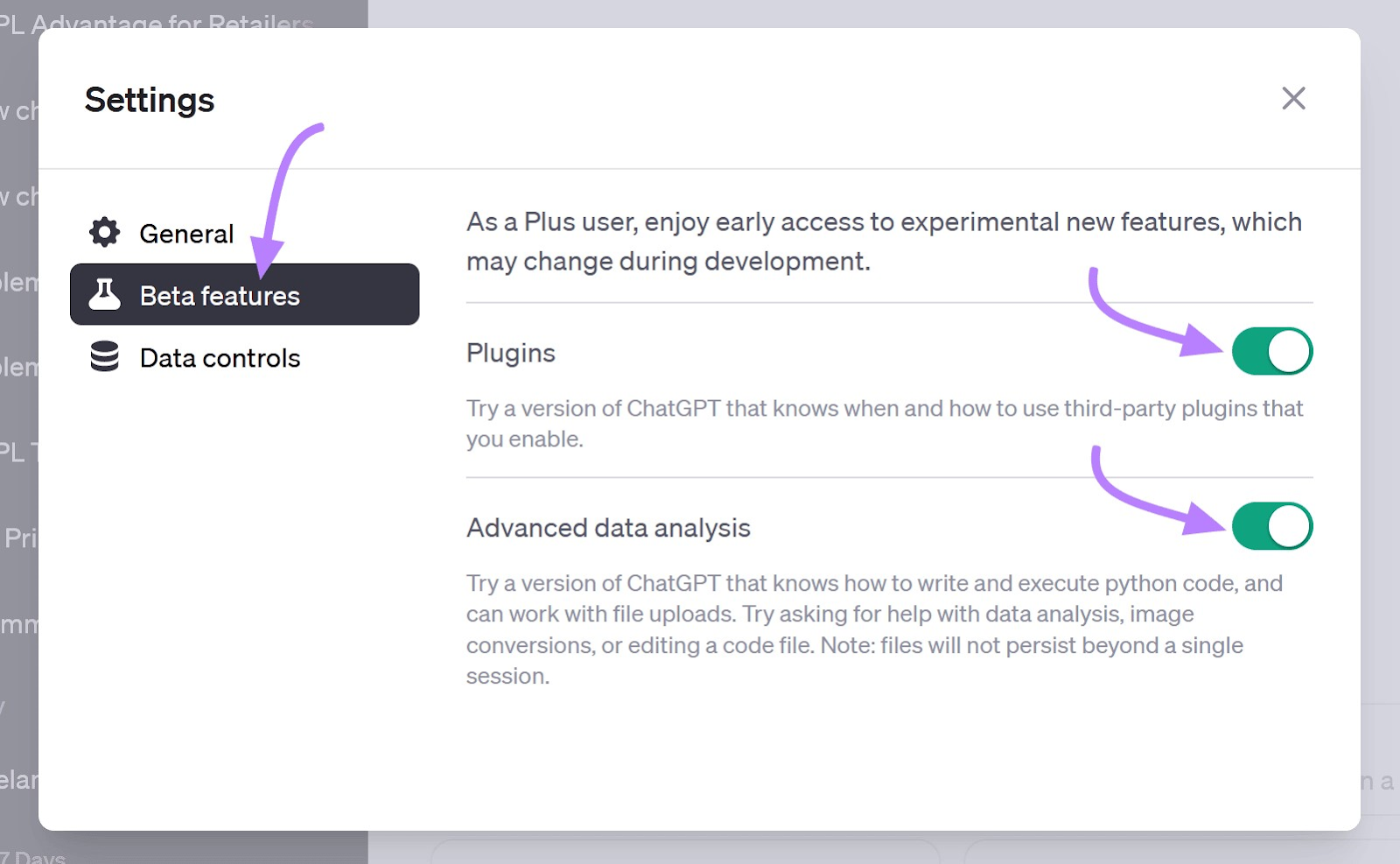
After that, you can explore the plugin store for any additional functionality you need.
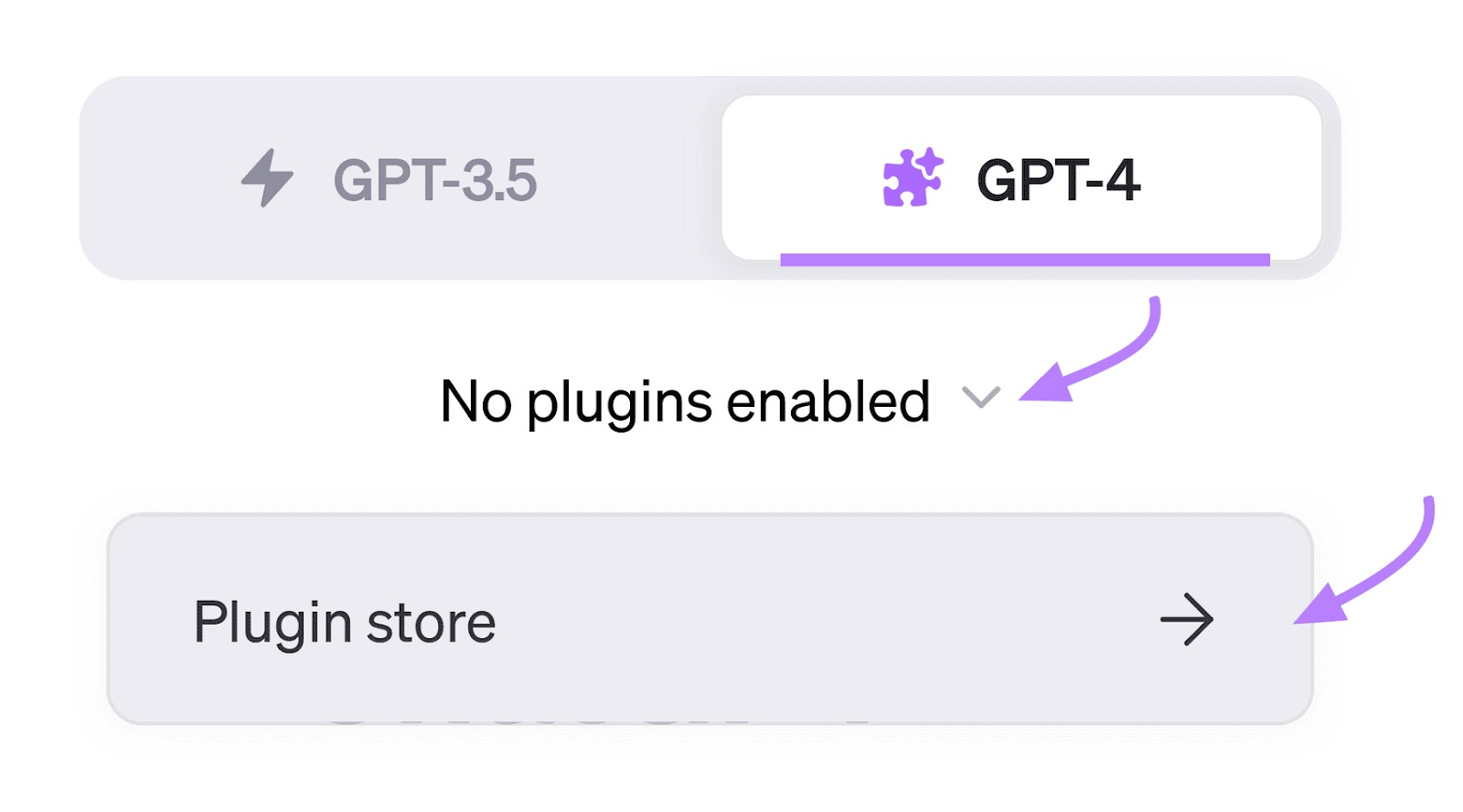
For instance, SEO Core AI analyzes your website’s performance. It then provides valuable insights and recommendations on optimizing your site and targeting keywords.
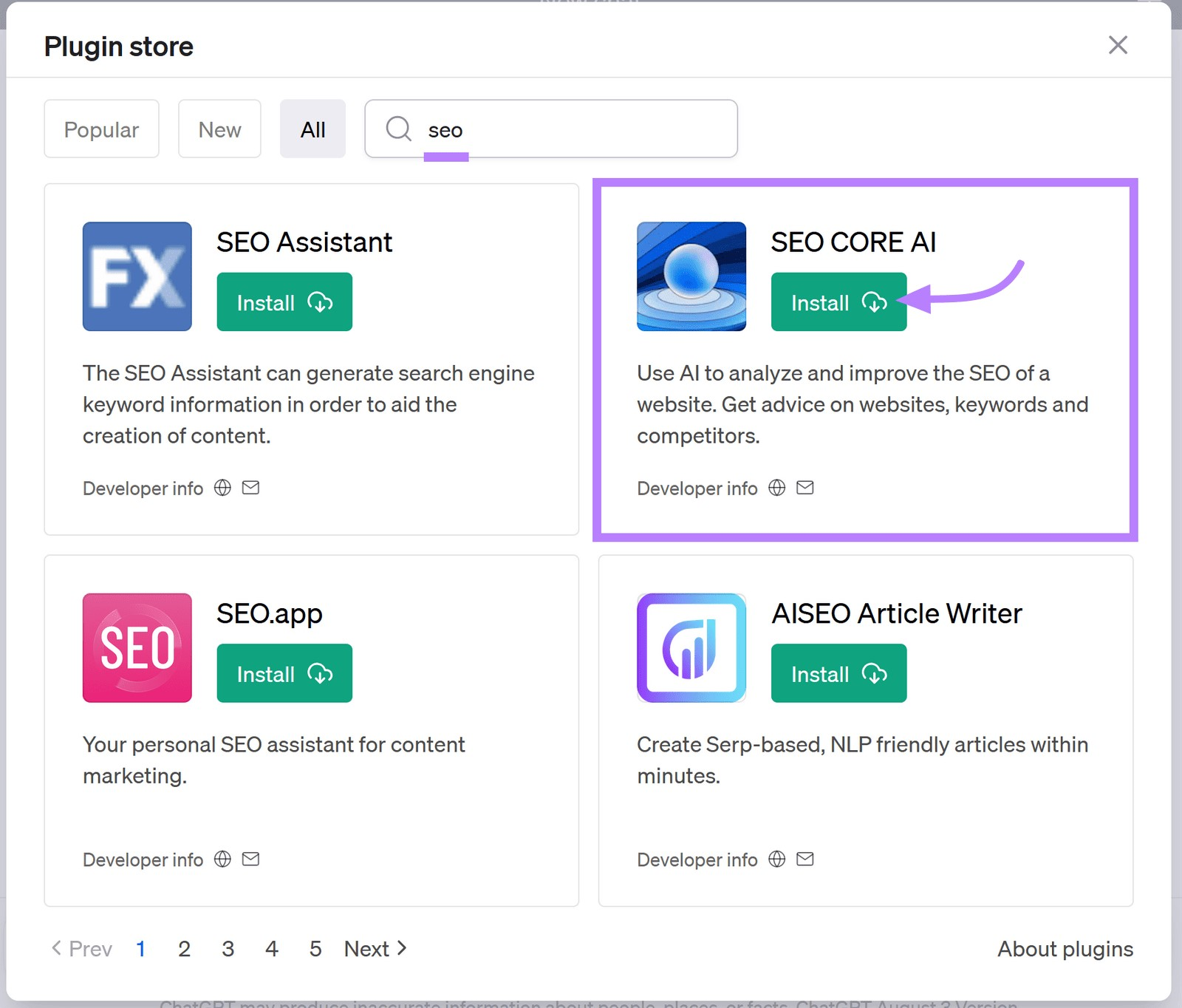
To activate the plugin, select it from the dropdown menu before you submit your prompt.
Here’s a prompt you can use with the Core AI plugin:
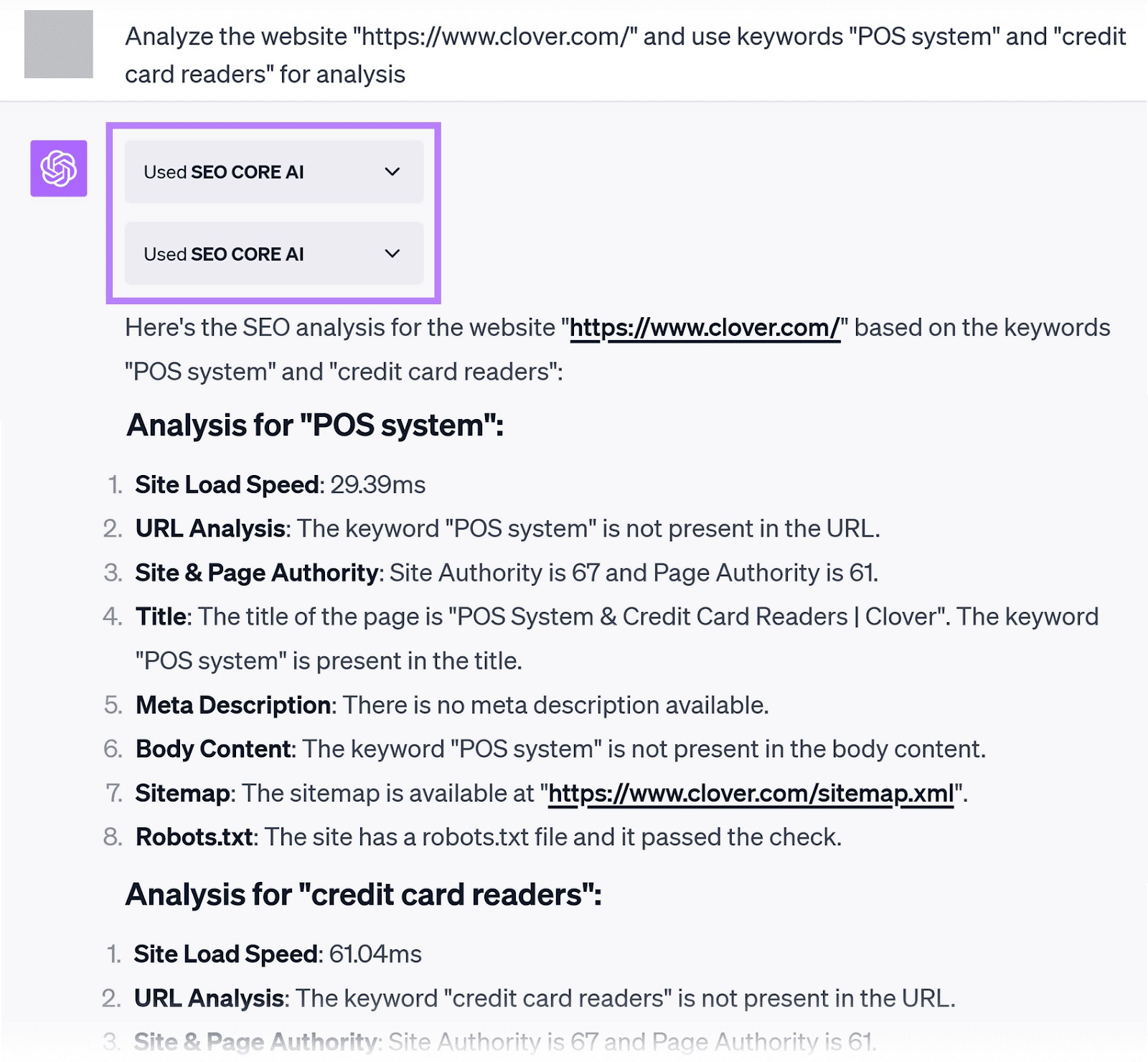
The output includes a short analysis of your website and recommended actions you can take to improve it. You can use the SEO Core AI plugin to regularly review and optimize your website for better performance.
With any output AI provides, take everything with a grain of salt and do some due diligence on your end.
Although the plugins aren’t a replacement for comprehensive analysis tools like Semrush, they can give you a good starting point.
What Are the Limitations of ChatGPT for SEO?
While ChatGPT is a powerful tool and can be a great help with SEO tasks, it has limitations:
Lack of Unique Content
ChatGPT generates content based on patterns it learned during training. Although it’s great at coming up with relevant and coherent responses, it doesn’t create truly unique content.
It’s not a substitute for the creativity and originality a human content creator can bring to the table.
And while ChatGPT won’t return plagiarized content, it may offer results that are very similar to existing online content. Or similar to results it’s provided for your competitors.
Search engines will penalize sites for duplicate content. So it’s important to oversee your AI content production and edit and refine it with a human touch.
Inaccurate Results
ChatGPT draws from content that’s already published. If the sources are incorrect, it will give incorrect output.
And that makes sense, doesn’t it? You’re relying on other people’s fact-checking and critical thinking instead of your own.
ChatGPT, as other AI chatbots, can also be prone to “hallucinations”—basically making up content. It’s programmed to analyze and replicate how people put words together, not explicitly to determine what’s true.
Because of this, it will return very plausible-sounding answers in a confident voice. But they may not be accurate.
For instance, reporters for the New York Times asked ChatGPT when that publication first reported on “artificial intelligence.” They shared the following “hallucination”:
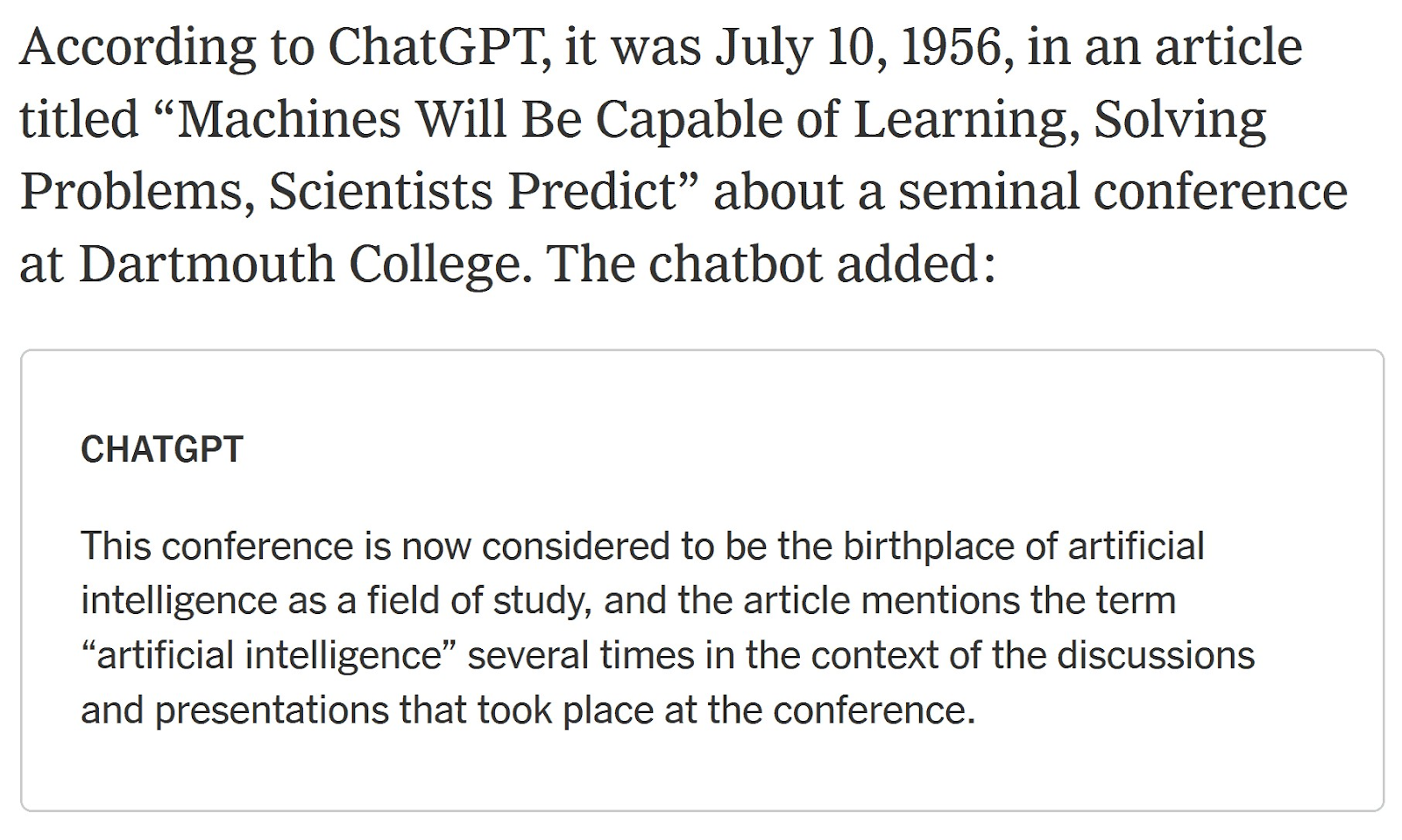
It turns out that while the conference really happened, the article referenced never existed.
It’s always a good idea to double-check any important information it provides and get relevant sources, especially regarding SEO where details and accuracy matter.
Outdated Information
ChatGPT’s training only includes data up to September 2021, so it isn’t aware of more recent developments.
For instance, when asked about plugins (which, as mentioned above, are available for paid subscribers), here’s how it responds:
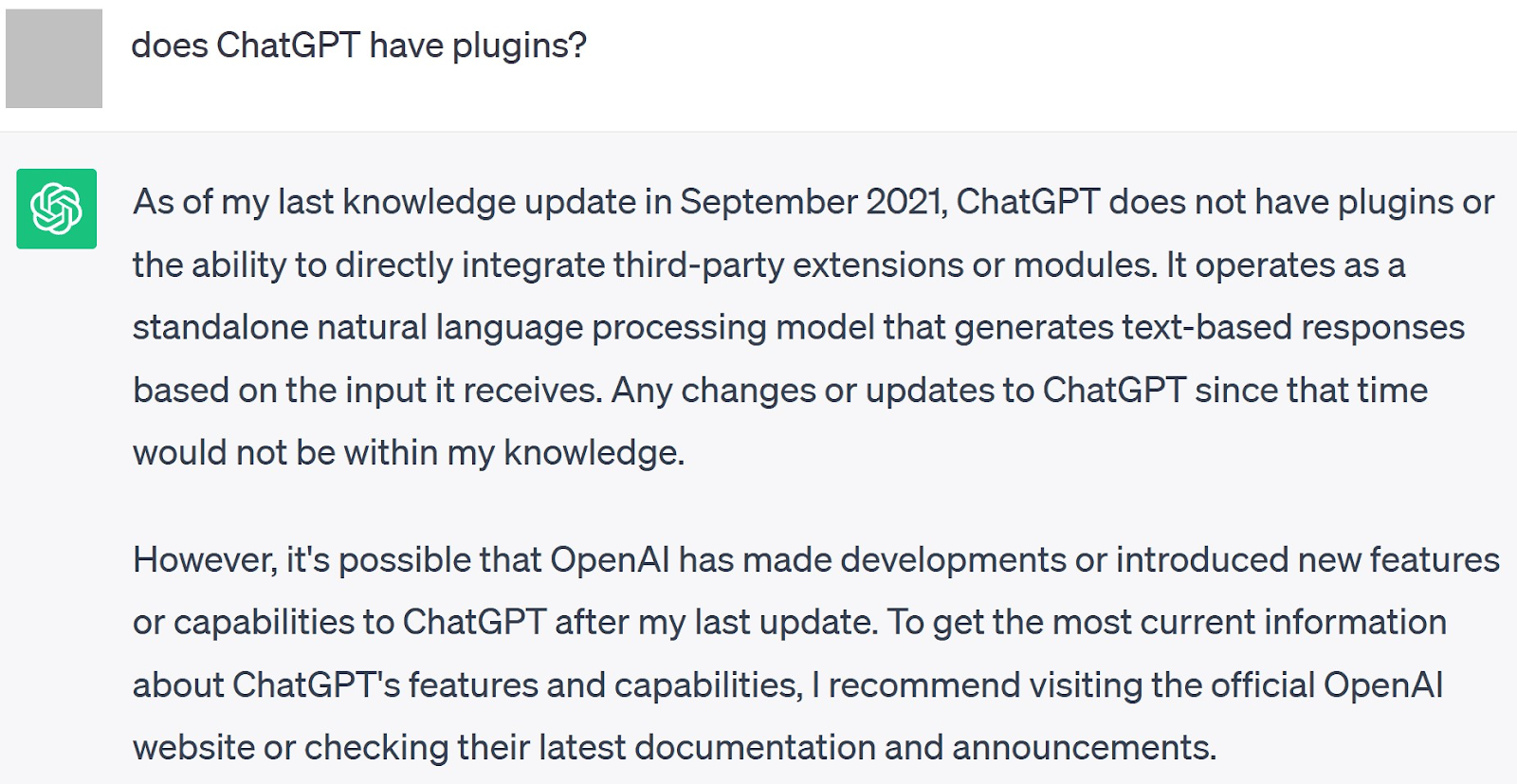
Note its disclaimer up front. It reports that there are no plugins for ChatGPT, but also acknowledges its limitations.
SEO changes regularly. You need to monitor the latest trends, algorithm updates, and best practices and get your updates from reliable sources.
Bridging the Gap: Combine ChatGPT with Human SEO Strategies
AI tools like ChatGPT can automate tasks, provide insights, and even generate content.
However, they’re not a standalone solution.
The real magic happens when you combine AI and other solutions with human expertise.
Using ChatGPT in tandem with dedicated tools will enhance your capabilities. Complement it with Semrush’s SEO Toolkit to assist you in every step of your website SEO.
